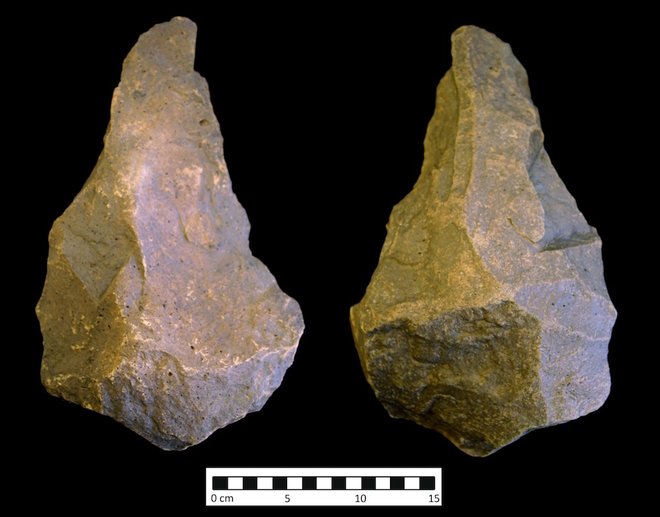
This handaxe weighs almost 8 pounds and is unusually heavy. It and many of the other stone artifacts at Wadi Dabsa date to some point between 1.76 million years ago and 100,000 years ago. Researchers are trying to determine a more precise date. Credit: Andrew Shuttleworth and Frederick Foulds
|
Ancient Axes, Spear Points May Reveal When Early Humans Left Africa
27 December 2017
More than 1,000 stone artifacts, some of which may be up to 1.76 million years old, have been discovered at Wadi Dabsa, in southwest Saudi Arabia near the Red Sea.
The artifacts, which were found in what is now an arid landscape, date to a time when the climate was wetter; they may provide clues as to how and when different hominins left Africa, researchers said.
The stone artifacts include the remains of hand axes, cleavers (a type of knife), scrapers (used to scrape the flesh off of animal hides), projectile points (that would have been attached to the ends of spears), piercers (stone tools that can cut small holes through hide or flesh) and hammer stones. One of the hand axes is unusually heavy, weighing just under 8 lbs. (3.6 kilograms), the researchers said. The discoveries were detailed in the December 2017 issue of the journal Antiquity. [The 25 Most Mysterious Archaeological Finds on Earth]
Based on the tool design, archaeologists said they can tell that many of the artifacts are "Acheulian," a term used to describe types of stone tools made between 1.76 million years and 100,000 years ago. When exactly within this time frame the various artifacts at Wadi Dabsa were made is uncertain, the archaeologists said.
"We hope to try and date the tufa [a type of limestone] and basalt flows within the site, which are associated [with] the large [stone artifact] assemblage recovered from within the wadi," said study lead author Frederick Foulds, an archaeology professor at Durham University in England. Once the team has more-precise dates for the artifacts, the scientists may be able to determine what type of hominins made the tools, Foulds said.
A wetter time
Archaeologists said they can already tell that the artifacts date to a time when the climate was wetter. "It's far more arid [today] than it was at certain points in time," Foulds told Live Science. "It's strange to be walking over hard, dry rocks which were formed by water pooling during a far wetter period. We think it was during these wetter periods that it's likely the site was occupied."
The climate of the entire Arabian Peninsula has changed multiple times in response to the massive changes in global climates that accompanied glacial cycles over the last 2.5 million years, Foulds said.
"During periods when the ice sheets were at their largest, there was widespread aridity in the Sahara and Arabian deserts, but during periods when the ice sheets shrank, the climate of these regions became a lot wetter," Foulds said.
One of the big questions is how the changes in climate affected the dispersal of hominins from out of Africa, Foulds said.
"What's interesting about the Wadi Dabsa region is that the geography of the region may have created a refuge from these changes," Foulds said.
Because of Wadi Dabsa's topography the region may have received rainfall when other parts of Saudi Arabia were arid. Hominins were able "to continue living there [at Wadi Dabsa] when they couldn't live in other areas," Foulds said. Researchers have found that Wadi Dabsa's topography includes a basin which may have had streams of water flowing down its slopes, the water possibly pooling in the basin.
The team is carrying out its research as part of the DISPERSE project, which is analyzing landscape and archaeological changes in Africa and Asia in order to better understand how humans evolved and dispersed out of Africa.
Source: https://www.livescience.com/61285-stone-tools-found-in-saudi-arabia.html
|

The astrolabe has the Portuguese royal coat of arms (top) and an
armillary sphere (bottom), which is the personal emblem of Dom Manuel I. Photograph by David Mearns, National Geographic Creative
|
Rare Solar Navigation Tool Found in Ancient Shipwreck
24 October 2017
When a small, 500-year-old copper disk was discovered among the remains of a shipwreck off the coast of Oman in 2014, archaeologists suspected it was a navigation tool called an astrolabe.
Now, thanks to 3D scanning technology, scientists are able to see the small faded measurements etched into the disk - which confirm that it is in fact an astrolabe. It is also now thought to be the earliest such find from a period known as the European Age of Exploration.
The disk was found on a ship called the Esmeralda, which belonged to a fleet led by the famous Portuguese explorer Vasco da Gama during his search for a route from Europe to India in 1502-1503.
In 2014, a team of excavators led by marine scientist David L. Mearns and his company Bluewater Discoveries Ltd. loosened the astrolabe from sand covering hundreds of other relics that sat on the sea floor. In an interim report they published last year on the find in the International Journal of Nautical Archaeology, they theorized that the disk was used for navigation.
A Portuguese royal coat of arms was visible on the disk's top half, and on the bottom was an etching of an armillary sphere, which Mearns claimed belonged to Portuguese King Dom Miguel. These etchings indicated to archeologists that the object was a "high-status" object aboard the Esmeralda.
While these markings suggested that the disk was used for navigation, Mearns and his team needed more proof before they could declare it with certainty.
That's where Mark Williams, a professor at the University of Warwick, and a team of engineers came in. They flew to Oman to scan and render 3D images of the 500-year-old artifact. Using a laser scanner that produces 80,000 measurement points per second, they were able to create a 3D model of the astrolabe.
What they saw on the scans wasn't visible to the naked eye - eighteen individual lines emerging from a hole in the center of the disk and arranged at five-degree increments.
"The markings were very fine and, due to damage to the surface, almost invisible to the human eye," said Williams. "The resolution of the 3D data allowed us to zoom in and identify the marks and subsequently characterize them."
Markings on astrolabes are used to measure angles. They're one of human civilization's most advanced ancient tools and are thought to have become popular just prior to the current era. By aligning an astrolabe perpendicular to the horizon, ancient astronomers could calculate measurements like time and position.
Astrolabes used by early sea explorers are frequently referred to as mariner's astrolabes. A broken bracket at the top of the disc indicates it was likely suspended to align it perpendicularly to the horizon. By measuring the altitude of the sun at noon, navigators could then measure the sun's declination, which accurately told sailors their latitude.
An Age of Discovery
The 15th century to the 17th century marked a period of booming European exploration, during which time European nations were fervently searching for maritime routes.
When da Gama embarked on his second voyage to India, around 1502-1503, he took with him a fleet of 20 ships, including the Esmeralda. European interest in Indian spices burgeoned during the 15th century, but passage to India was largely controlled by Arab rulers. da Gama become the first to chart a nautical path directly to India by sailing around the horn of Africa.
Stories passed down from witnesses and damage on part of the ship's remains indicate it probably sank from a storm that smashed it into deadly rocks. The remains were initially located in 1998, but it wasn't until 2013 that Mearns - supported in part by the National Geographic Society Expeditions Council - unearthed thousands of the ship's treasures.
"We really don't know much about early astrolabes, so this one is precious from that viewpoint," said Luis Filipe Viera de Castro, a professor of nautical archaeology at Texas A&M University. Previously, the earliest known example of a mariner's astrolabe was dated to a 1554 Spanish shipwreck that sank near the coast of south Texas.
"It is also precious because it almost certainly comes from one of Vicente Sodré's lost ships, and these were probably the first European warships to enter the Indian Ocean," said Castro.
Vicente Sodré was da Gama's maternal uncle and commander of the Esmeralda. Cannonballs bearing his initials were found among the watery wreckage. Instructed by da Gama to guard Portuguese factories off the coast of India, the Sodré brothers instead sailed to the Gulf of Aden, where they looted Arab ships. Both Vicente and his brother Brás died when the ships sank during a storm.
Source: https://news.nationalgeographic.com/2017/10/navigation-tool-astrolabe-vasco-da-gama-shipwreck-esmeralda-spd/
|

The Lamont-Doherty Core Repository contains one
of the world's most unique and important collection of scientific samples from the deep sea. Sediment cores from every major ocean
and sea are archived here. The repository provides
for long-term curation and archiving of samples and cores to ensure their preservation and
usefulness to current and future generations of scientists.
Credit: Courtesy Lamont-Doherty Earth Observatory
|
Ancient humans left Africa to escape drying climate
5 October 2017
Humans migrated out of Africa as the climate shifted from wet to very dry about 60,000 years ago, according to research led by a University of Arizona geoscientist.
Genetic research indicates people migrated from Africa into Eurasia between 70,000 and 55,000 years ago. Previous researchers suggested the climate must have been wetter than it is now for people to migrate to Eurasia by crossing the Horn of Africa and the Middle East.
"There's always been a question about whether climate change had any influence on when our species left Africa," said Jessica Tierney, UA associate professor of geosciences. "Our data suggest that when most of our species left Africa, it was dry and not wet in northeast Africa."
Tierney and her colleagues found that around 70,000 years ago, climate in the Horn of Africa shifted from a wet phase called "Green Sahara" to even drier than the region is now. The region also became colder.
The researchers traced the Horn of Africa's climate 200,000 years into the past by analyzing a core of ocean sediment taken in the western end of the Gulf of Aden. Tierney said before this research there was no record of the climate of northeast Africa back to the time of human migration out of Africa.
"Our data say the migration comes after a big environmental change. Perhaps people left because the environment was deteriorating," she said. "There was a big shift to dry and that could have been a motivating force for migration."
"It's interesting to think about how our ancestors interacted with climate," she said.
The team's paper, "A climatic context for the out-of-Africa migration," is published online in Geology this week. Tierney's co-authors are Peter deMenocal of the Lamont-Doherty Earth Observatory in Palisades, New York, and Paul Zander of the UA.
The National Science Foundation and the David and Lucile Packard Foundation funded the research.
Tierney and her colleagues had successfully revealed the Horn of Africa's climate back to 40,000 years ago by studying cores of marine sediment. The team hoped to use the same means to reconstruct the region's climate back to the time 55,000 to 70,000 years ago when our ancestors left Africa.
The first challenge was finding a core from that region with sediments that old. The researchers enlisted the help of the curators of the Lamont-Doherty Core Repository, which has sediment cores from every major ocean and sea. The curators found a core collected off the Horn of Africa in 1965 from the R/V Robert D. Conrad that might be suitable.
Co-author deMenocal studied and dated the layers of the 1965 core and found it had sediments going back as far as 200,000 years.
At the UA, Tierney and Paul Zander teased out temperature and rainfall records from the organic matter preserved in the sediment layers. The scientists took samples from the core about every four inches (10 cm), a distance that represented about every 1,600 years.
To construct a long-term temperature record for the Horn of Africa, the researchers analyzed the sediment layers for chemicals called alkenones made by a particular kind of marine algae. The algae change the composition of the alkenones depending on the water temperature. The ratio of the different alkenones indicates the sea surface temperature when the algae were alive and also reflects regional temperatures, Tierney said.
To figure out the region's ancient rainfall patterns from the sediment core, the researchers analyzed the ancient leaf wax that had blown into the ocean from terrestrial plants. Because plants alter the chemical composition of the wax on their leaves depending on how dry or wet the climate is, the leaf wax from the sediment core's layers provides a record of past fluctuations in rainfall.
The analyses showed that the time people migrated out of Africa coincided with a big shift to a much drier and colder climate, Tierney said.
The team's findings are corroborated by research from other investigators who reconstructed past regional climate by using data gathered from a cave formation in Israel and a sediment core from the eastern Mediterranean. Those findings suggest that it was dry everywhere in northeast Africa, she said.
"Our main point is kind of simple," Tierney said. "We think it was dry when people left Africa and went on to other parts of the world, and that the transition from a Green Sahara to dry was a motivating force for people to leave."
Source: http://popular-archaeology.com/issue/fall-2017/article/ancient-humans-left-africa-to-escape-drying-climate
|
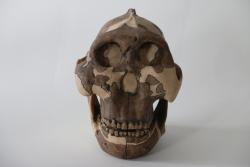
A cast of a P. boisei skull, used for teaching at Cambridge University. Credit: Louise Walsh
|
Meet the hominin species that gave us genital herpes
3 October 2017
Two herpes simplex viruses infect primates from unknown evolutionary depths. In modern humans these viruses manifest as cold sores (HSV1) and genital herpes (HSV2).
Unlike HSV1, however, the earliest proto-humans did not take HSV2 with them when our ancient lineage split from chimpanzee precursors around 7 million years ago. Humanity dodged the genital herpes bullet - almost.
Somewhere between 3 and 1.4 million years ago, HSV2 jumped the species barrier from African apes back into human ancestors - probably through an intermediate hominin species unrelated to humans. Hominin is the zoological 'tribe' to which our species belongs.
Now, a team of scientists from Cambridge and Oxford Brookes universities believe they may have identified the culprit: Paranthropus boisei, a heavyset bipedal hominin with a smallish brain and dish-like face.
In a study published today in the journal Virus Evolution, they suggest that P. boisei most likely contracted HSV2 through scavenging ancestral chimp meat where savannah met forest - the infection seeping in via bites or open sores.
Hominins with HSV1 may have been initially protected from HSV2, which also occupied the mouth. That is until HSV2 "adapted to a different mucosal niche" say the scientists. A niche located in the genitals.
Close contact between P. boisei and our ancestor Homo erectus would have been fairly common around sources of water, such as Kenya's Lake Turkana. This provided the opportunity for HSV2 to boomerang into our bloodline.
The appearance of Homo erectus around 2 million years ago was accompanied by evidence of hunting and butchery. Once again, consuming "infected material" would have transmitted the virus - only this time it was P. boisei being devoured.
"Herpes infect everything from humans to coral, with each species having its own specific set of viruses," said senior author Dr Charlotte Houldcroft, a virologist from Cambridge's Department of Archaeology.
"For these viruses to jump species barriers they need a lucky genetic mutation combined with significant fluid exchange. In the case of early hominins, this means through consumption or intercourse - or possibly both."
"By modelling the available data, from fossil records to viral genetics, we believe that Paranthropus boisei was the species in the right place at the right time to both contract HSV2 from ancestral chimpanzees, and transmit it to our earliest ancestors, probably Homo erectus."
When researchers from University of California, San Diego, published findings suggesting HSV2 had jumped between hominin species, Houldcroft became curious.
While discussing genital herpes over dinner at Kings College, Cambridge, with fellow academic Dr Krishna Kumar, an idea formed. Kumar, an engineer who uses Bayesian network modelling to predict city-scale infrastructure requirements, suggested applying his techniques to the question of ancient HSV2.
Houldcroft and her collaborator Dr Simon Underdown, a human evolution researcher from Oxford Brookes, collated data ranging from fossil finds to herpes DNA and ancient African climates. Using Kumar's model, the team generated HSV2 transmission probabilities for the mosaic of hominin species that roamed Africa during "deep time".
"Climate fluctuations over millennia caused forests and lakes to expand and contract," said Underdown. "Layering climate data with fossil locations helped us determine the species most likely to come into contact with ancestral chimpanzees in the forests, as well as other hominins at water sources."
Some promising leads turned out to be dead ends. Australopithecus afarensis had the highest probability of proximity to ancestral chimps, but geography also ruled it out of transmitting to human ancestors.
Ultimately, the researchers discovered the key player in all the scenarios with higher probabilities to be Paranthropus boisei. A genetic fit virally who was found in the right places to be the herpes intermediary, with Homo erectus - and eventually us - the unfortunate recipients.
"Once HSV2 gains entry to a species it stays, easily transferred from mother to baby, as well as through blood, saliva and sex," said Houldcroft.
"HSV2 is ideally suited to low density populations. The genital herpes virus would have crept across Africa the way it creeps down nerve endings in our sex organs - slowly but surely."
The team believe their methodology can be used to unravel the transmission mysteries of other ancient diseases - such as human pubic lice, also introduced via an intermediate hominin from ancestral gorillas over 3 million years ago.
Source: http://popular-archaeology.com/issue/fall-2017/article/meet-the-hominin-species-that-gave-us-genital-herpes
|

Sorghum (Sorghum bicolor). Image credit: Pethan, Botanical Gardens, Utrecht University / CC BY-SA 3.0.
|
Earliest Evidence of Domesticated Sorghum Discovered
28 September 2017
Sorghum was domesticated from its wild ancestor more than 5,000 years ago, according to archaeological evidence uncovered by University College London archaeologist Dorian Fuller and colleagues in Sudan.
Sorghum (Sorghum bicolor) is a native African grass that was utilized for thousands of years by prehistoric peoples, and emerged as one of the world's five most important cereal crops, along with rice, wheat, barley, and maize.
For a half century scientists have hypothesized that native African groups were domesticating sorghum outside the winter rainfall zone of the ancient Egyptian Nile Valley - where wheat and barley cereals were predominant - in the semi-arid tropics of Africa, but no archaeological evidence existed.
The newest evidence comes from an archaeological site near Kassala in eastern Sudan, dating from 3500 to 3000 BC, and is associated with the Butana Group culture.
"This new discovery in eastern Sudan reveals that during the 4th millennium BC, peoples of the Butana Group were intensively cultivating wild stands of sorghum until they began to change the plant genetically into domesticated morphotypes," Dr. Fuller and co-authors said.
The researchers examined plant impressions within broken pottery from the largest Butana Group site, KG23.
"Ceramic sherds recovered from excavations undertaken by the Southern Methodist University Butana Project during the 1980s from the KG23 site were analyzed," they explained.
"Examination of the plant impressions in the pottery revealed diagnostic chaff in which both domesticated and wild sorghum types were identified, thus providing archaeobotanical evidence for the beginnings of cultivation and emergence of domesticated characteristics within sorghum during the 4th millennium BC in eastern Sudan."
"Along with the recent discovery of domesticated pearl millet in eastern Mali around 2500 BC, this discovery pushes back the process for domesticating summer rainfall cereals another thousand years in the Sahel, with sorghum, providing new evidence for the earliest known native African cultigen," they said.
The research is published in the journal Current Anthropology.
Source: http://www.sci-news.com/archaeology/earliest-evidence-domesticated-sorghum-05271.html
|
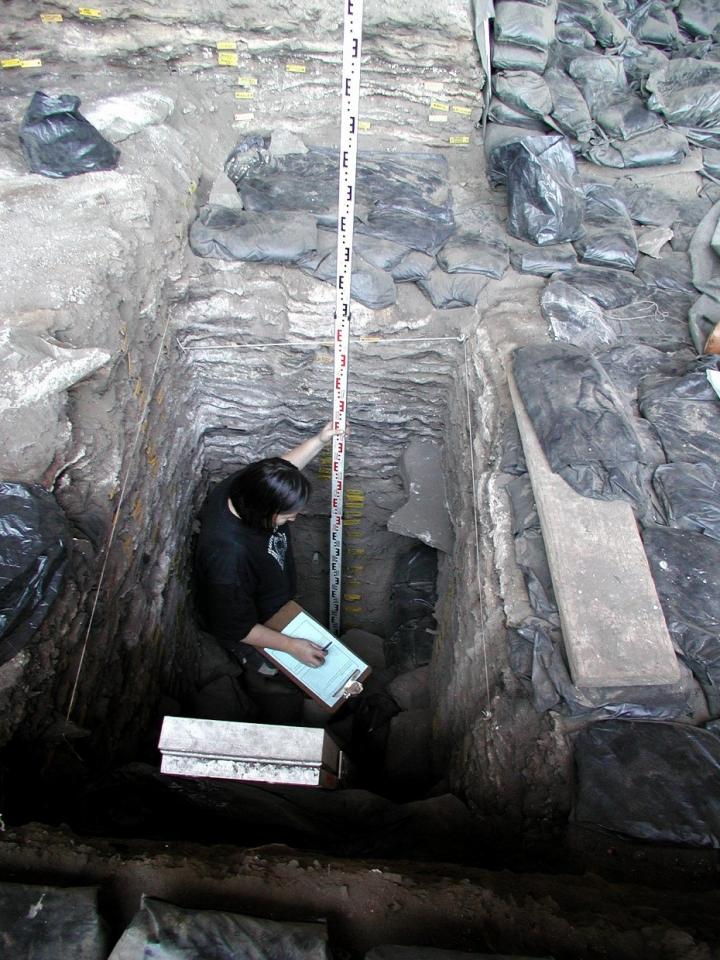
This is Marlize Lombard (University of
Johannesburg) excavating
at Sibudu Cave (under
the direction of Prof Lyn Wadley, University of the Witwatersrand), about
40 km southeast of
Ballito Bay where the boy was found. The cave was intermittently occupied by humans from at least 77 000 years ago who might have been ancestral to
the Ballito boy.
Photograph: Lyn Wadley, University of the Witwatersrand.
|
Stone Age child reveals that modern humans emerged more than 300,000 years ago
28 September 2017
South Africa is well-known for its hominin fossil record. But this time, results from a study of ancient DNA presented in the September 28th First Release early online issue of Science show that the 2000-year-old remains of a boy found at Ballito Bay in KwaZulu-Natal during the 1960s, helped to rewrite human history.
Marlize Lombard, Professor of Stone Age archaeology at the University of Johannesburg, initiated collaboration with geneticists from Uppsala University in Sweden and the University of the Witwatersrand, who put together a team of experts at the Uppsala laboratory.
They reconstructed the full genome of the Ballito Bay child, together with the genomes of six other individuals from KwaZulu-Natal who lived between 2300 and 300 years ago.
Three Stone Age individuals who lived between 2300 and 1800 years ago were found to be genetically related to the descendants of Khoe-San groups living in southern Africa today. The remains of the other four individuals who lived 500-300 years ago during the Iron Age, were genetically related to present-day South Africans of West African descent.
Because the boy from Ballito Bay was of hunter-gatherer descent, living at a time before migrants from further north in Africa reached South African shores, his DNA could be used to estimate the split between modern humans and earlier human groups as occurring between 350 000 and 260 000 years ago. "This means that modern humans emerged earlier than previously thought", says Mattias Jakobsson, population geneticist at Uppsala University, who headed the project together with Marlize Lombard from the University of Johannesburg.
The 350 000 to 260 000 years estimate also coincides with the Florisbad skull, who was a contemporary of the small-brained Homo naledi in South Africa. "It now seems that at least two or three Homo species occupied the southern African landscape during this time, which also represents the early phases of the Middle Stone Age", says Lombard.
Cumulatively, the fossil, ancient DNA and archaeological records indicate that the transition from archaic to modern humans might not have occurred in only one place in Africa. Instead, regions including southern and northern Africa (as recently reported) probably played a role. "Thus, both palaeo-anthropological and genetic evidence increasingly points to multiregional origins of anatomically modern humans in Africa, i.e. Homo sapiens did not originate in one place in Africa, but might have evolved from older forms in several places on the continent with gene flow between groups from different places", says Carina Schlebusch.
These findings from South Africa shed new light on our species' deep African history and show that there is still much more to learn about our process of becoming modern humans. The results of this study also emphasise that the interplay between genetics and archaeology has an increasingly important role to play.
Source: https://www.eurekalert.org/pub_releases/2017-09/uoj-sac092817.php
|

Mount Hora in Malawi,
where the oldest DNA in
the study, from a woman who lived more than
8,000 years ago, was obtained.
Credit: Jessica C. Thompson/Emory
University
|
Ancient human DNA in sub-Saharan Africa lifts veil on prehistory
21 September 2017
The first large-scale study of ancient human DNA from sub-Saharan Africa opens a long-awaited window into the identity of prehistoric populations in the region and how they moved around and replaced one another over the past 8,000 years.
The findings, published Sept. 21 in Cell by an international research team led by Harvard Medical School, answer several longstanding mysteries and uncover surprising details about sub-Saharan African ancestry - including genetic adaptations for a hunter-gatherer lifestyle and the first glimpses of population distribution before farmers and animal herders swept across the continent about 3,000 years ago.
"The last few thousand years were an incredibly rich and formative period that is key to understanding how populations in Africa got to where they are today," said David Reich, professor of genetics at HMS and a senior associate member of the Broad Institute of MIT and Harvard. "Ancestry during this time period is such an unexplored landscape that everything we learned was new."
Reich shares senior authorship of the study with Ron Pinhasi of the University of Vienna and Johannes Krause of the Max Planck Institute for the Science of Human History and the University of Tübingen in Germany.
"Ancient DNA is the only tool we have for characterizing past genomic diversity. It teaches us things we don't know about history from archaeology and linguistics and can help us better understand present-day populations," said Pontus Skoglund, a postdoctoral researcher in the Reich lab and the study's first author. "We need to ensure we use it for the benefit of all populations around the world, perhaps especially Africa, which contains the greatest human genetic diversity in the world but has been underserved by the genomics community."
Long time coming
Although ancient-DNA research has revealed insights into the population histories of many areas of the world, delving into the deep ancestry of African groups wasn't possible until recently because genetic material degrades too rapidly in warm, humid climates.
Technological advances - including the discovery by Pinhasi and colleagues that DNA persists longer in small, dense ear bones - are now beginning to break the climate barrier. Last year, Reich and colleagues used the new techniques to generate the first genome-wide data from the earliest farmers in the Near East, who lived between 8,000 and 12,000 years ago.
In the new study, Skoglund and team, including colleagues from South Africa, Malawi, Tanzania and Kenya, coaxed DNA from the remains of 15 ancient sub-Saharan Africans. The individuals came from a variety of geographic regions and ranged in age from about 500 to 8,500 years old.
The researchers compared these ancient genomes - along with the only other known ancient genome from the region, previously published in 2015 - against those of nearly 600 present-day people from 59 African populations and 300 people from 142 non-African groups.
With each analysis, revelations rolled in.
"We are peeling back the first layers of the agricultural transition south of the Sahara," said Skoglund. "Already we can see that there was a whole different landscape of populations just 2,000 or 3,000 years ago."
Genomic time-lapse
Almost half of the team's samples came from Malawi, providing a series of genomic snapshots from the same location across thousands of years.
The time-series divulged the existence of an ancient hunter-gatherer population the researchers hadn't expected.
When agriculture spread in Europe and East Asia, farmers and animal herders expanded into new areas and mixed with the hunter-gatherers who lived there. Present-day populations thus inherited DNA from both groups.
The new study found evidence for similar movement and mixing in other parts of Africa, but after farmers reached Malawi, hunter-gatherers seem to have disappeared without contributing any detectable ancestry to the people who live there today.
"It looks like there was a complete population replacement," said Reich. "We haven't seen clear evidence for an event like this anywhere else."
The Malawi snapshots also helped identify a population that spanned from the southern tip of Africa all the way to the equator about 1,400 years ago before fading away. That mysterious group shared ancestry with today's Khoe-San (or Khoisan) people in southern Africa and left a few DNA traces in people from a group of islands thousands of miles away, off the coast of Tanzania.
"It's amazing to see these populations in the DNA that don't exist anymore," said Reich. "It's clear that gathering additional DNA samples will teach us much more."
"The Khoe-San are such a genetically distinctive people, it was a surprise to find a closely related ancestor so far north just a couple of thousand years ago," Reich added.
The new study also found that West Africans can trace their lineage back to a human ancestor that may have split off from other African populations even earlier than the Khoe-San.
Missing links
The research similarly shed light on the origins of another unique group, the Hadza people of East Africa.
"They have a distinct appearance, language and genetics, and some people speculated that, like the Khoe-San, they might represent a very early diverging group from other African populations," said Reich. "Our study shows that instead, they're somehow in the middle of everything."
The Hadza, according to genomic comparisons, are today more closely related to non-Africans than to other Africans. The researchers hypothesize that the Hadza are direct descendants of the group that migrated out of Africa, and possibly spread within Africa as well, after about 50,000 years ago.
Another discovery lay in wait in East Africa.
Scientists had predicted the existence of an ancient population based on the observation that present-day people in southern Africa share ancestry with people in the Near East. The 3,000-year-old remains of a young girl in Tanzania provided the missing evidence.
Reich and colleagues suspect that the girl belonged to a herding population that contributed significant ancestry to present-day people from Ethiopia and Somalia down to South Africa. The ancient population was about one-third Eurasian, and the researchers were able to further pinpoint that ancestry to the Levant region.
"With this sample in hand, we can now say more about who these people were," said Skoglund.
The finding put one mystery to rest while raising another: Present-day people in the Horn of Africa have additional Near Eastern ancestry that can't be explained by the group to which the young girl belonged.
Natural selection
Finally, the study took a first step in using ancient DNA to understand genetic adaptation in African populations.
It required "squeezing water out of a stone" because the researchers were working with so few ancient samples, said Reich, but Skoglund was able to identify two regions of the genome that appear to have undergone natural selection in southern Africans.
One adaptation increased protection from ultraviolet radiation, which the researchers propose could be related to life in the Kalahari Desert. The other variant was located on genes related to taste buds, which the researchers point out can help people detect poisons in plants.
The researchers hope that their study encourages more investigation into the diverse genetic landscape of human populations in Africa, both past and present. Reich also said he hopes the work reminds people that African history didn't end 50,000 years ago when groups of humans began migrating into the Near East and beyond.
"The late Stone Age in Africa is like a black hole, research-wise," said Reich. "Ancient DNA can address that gap."
Source: https://phys.org/news/2017-09-ancient-human-dna-sub-saharan-africa.html
|
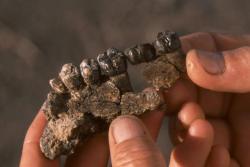
Partial upper jaw of Australopithecus anamensis, a primitive hominin, recovered from
the bone bed excavated
at the Allia Bay site.
Photo courtesy of Meave Leakey, PhD
|
When ancient fossil DNA isn't available, ancient glycans may help trace human evolution
11September 2017
UNIVERSITY OF CALIFORNIA - SAN DIEGO - Ancient DNA recovered from fossils is a valuable tool to study evolution and anthropology. Yet ancient fossil DNA from earlier geological ages has not been found yet in any part of Africa, where it's destroyed by extreme heat and humidity. In a potential first step at overcoming this hurdle, researchers at University of California San Diego School of Medicine and Turkana Basin Institute in Kenya have discovered a new kind of glycan - a type of sugar chain - that survives even in a 4 million-year-old animal fossil from Kenya, under conditions where ancient DNA does not.
While ancient fossils from hominins (human ancestors and extinct relatives) are not yet available for glycan analysis, this proof-of-concept study, published September 11 in Proceedings of the National Academy of Sciences, may set the stage for unprecedented explorations of human origins and diet.
"In recent decades, many new hominin fossils were discovered and considered to be the ancestors of humans," said Ajit Varki, MD, Distinguished Professor of Medicine and Cellular and Molecular Medicine at UC San Diego School of Medicine. "But it's not possible that all gave rise to modern humans - it's more likely that there were many human-like species over time, only one from which we descended. This new type of glycan we found may give us a better way to investigate which lineage is ours, as well as answer many other questions about our evolution, and our propensity to consume red meat."
Glycans are complex sugar chains on the surfaces of all cells. They mediate interaction between cells and the environment, and often serve as docking sites for pathogens. For millions of years, the common ancestors of humans and other apes shared a particular glycan known as Neu5Gc. Then, for reasons possibly linked to a malarial parasite that exploited Neu5Gc as a means to establish infection, a mutation that probably occurred between 2 and 3 million years ago inactivated the human gene encoding the enzyme that makes the molecule. The loss of Neu5Gc amounted to a radical molecular makeover of human ancestral cell surfaces and might have created a fertility barrier that expedited the divergence of the lineage leading to humans.
Today, chimpanzees and most other mammals still produce Neu5Gc. In contrast, only trace amounts can be detected in human blood and tissue—not because we make Neu5Gc, but, according to a previous study by Varki's team, because we accumulate the glycan when eating Neu5Gc rich red meat. Humans mount an immune response to this non-native Neu5Gc, possibly aggravating diseases such as cancer.
In their latest study, Varki and team found that, as part of its natural breakdown, a signature part of Neu5Gc is also incorporated into chondroitin sulfate (CS), an abundant component in bone. They detected this newly discovered molecule, called Gc-CS, in a variety of mammalian samples, including easily detectable amounts in chimpanzee bones and mouse tissues.
Like Neu5Gc, they found that human cells and serum have only trace amounts of Gc-CS - again, likely from red meat consumption. The researchers backed up that assumption with the finding that mice engineered to lack Neu5Gc and Gc-Cs (similar to humans) had detectable Gc-CS only when fed Neu5Gc-containing chow.
Curious to see how stable and long-lasting Gc-CS might be, Varki bought a relatively inexpensive 50,000-year-old cave bear fossil at a public fossil show and took it back to the lab. Despite its age, the fossil indeed contained Gc-CS.
That's when Varki turned to a long-time collaborator-paleoanthropologist and famed fossil hunter Meave Leakey, PhD, of Turkana Basin Institute of Kenya and Stony Brook University. Knowing that researchers need to make a very strong case before they are given precious ancient hominin fossil samples, even for DNA analysis, Leakey recommended that the researchers first prove their method by detecting Gc-CS in even older animal fossils. To that end, with the permission of the National Museums of Kenya, she gave them a fragment of a 4-million-year-old fossil from a buffalo-like animal recovered in the excavation of a bone bed at Allia Bay, in the Turkana Basin of northern Kenya. Hominin fossils were also recovered from the same horizon in this bone bed.
Varki and team were still able to recover Gc-CS in these much older fossils. If they eventually find Gc-Cs in ancient hominin fossils as well, the researchers say it could open up all kinds of interesting possibilities.
"Once we've refined our technique to the point that we need smaller sample amounts and are able to obtain ancient hominin fossils from Africa, we may eventually be able to classify them into two groups - those that have Gc-CS and those that do not. Those that lack the molecule would mostly likely belong to the lineage that led to modern humans," said Varki, who is also adjunct professor at the Salk Institute for Biological Studies and co-director of the UC San Diego/Salk Center for Academic Research and Training in Anthropogeny (CARTA).
In a parallel line of inquiry, Varki hopes Gc-CS detection will also reveal the point in evolution when humans began consuming large amounts of red meat.
"It's possible we'll one day find three groups of hominin fossils - those with Gc-CS before the human lineage branched off, those without Gc-CS in our direct lineage, and then more recent fossils in which trace amounts of Gc-CS began to reappear when our ancestors began eating red meat," Varki said. "Or maybe our ancestors lost Gc-CS more gradually, or only after we began eating red meat. It will be interesting to see, and we can begin asking these questions now that we know we can reliably find Gc-CS in ancient fossils in Africa."
Leakey is also hopeful about the role Gc-CS could play in the future, as an alternative to current approaches.
"Because DNA rapidly degrades in the tropics, genetic studies are not possible in fossils of human ancestors older than only a few thousand years," she said. "Therefore such ancient glycan studies have the potential to provide a new and important method for the investigation of human origins."
Source: http://popular-archaeology.com/issue/summer-2017/article/when-ancient-fossil-dna-isn-t-available-ancient-glycans-may-help-trace-human-evolution
|
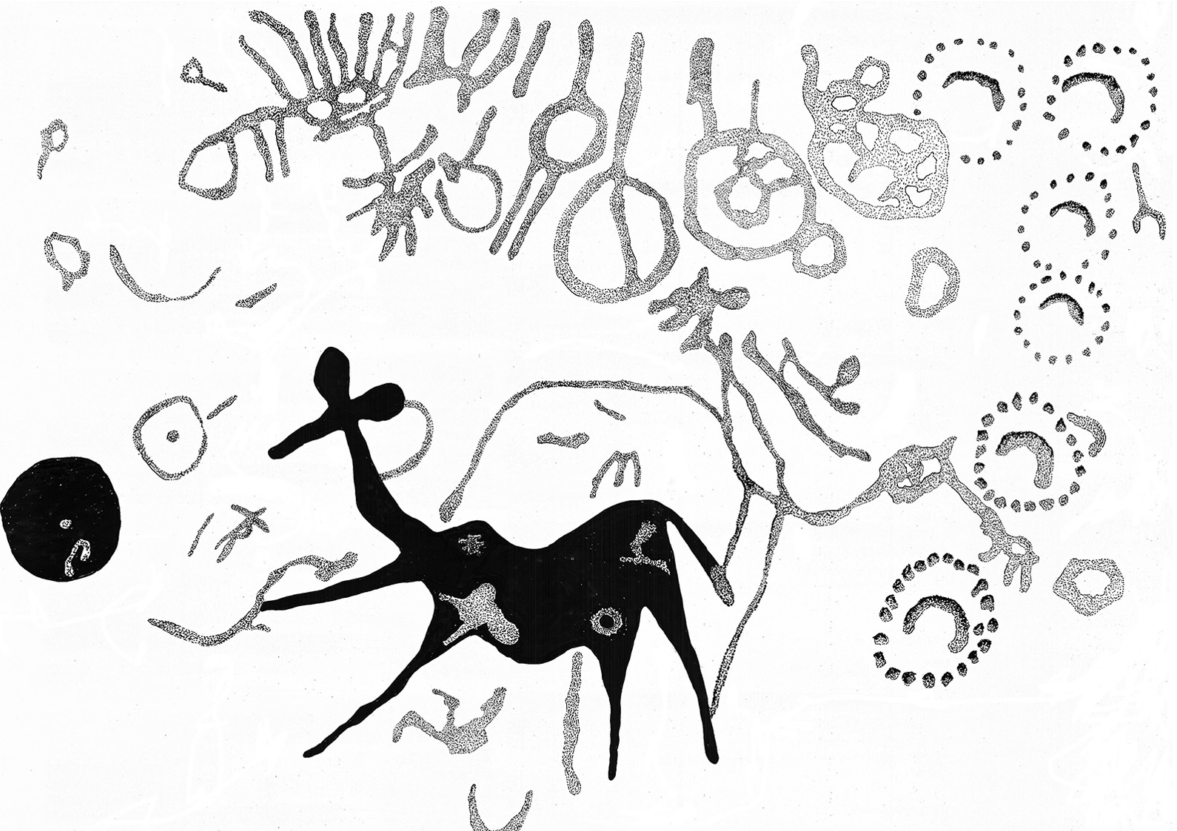
The dancing Kudu sheds light on ancient rituals.
John Kinahan/Figure 3. Antiquity doi:10.15184/aqy.2017.48
|
Rock art found in Namib Desert reveals ancient initiation rituals led by shamans
9 August 2017
In the Namib Desert, a long arid stretch that extends for 2,000 km on the south-western coast of Africa, ancient rock art is revealing tantalising clues about the ancient hunter-gatherer societies that lived in the region thousands of years ago.
The Namib Desert Archaeological Survey is the largest area study ever undertaken in Namibia, documenting evidence of human responses to climatic shifts and the creation of a unique culture in a hyper-arid environment. Among the most remarkable archaeological features that have been investigated is the wealth of art that bears witness to the rich spiritual beliefs of hunter-gatherers and the crucial role played by shamans in their communities.
Perhaps one of the most intriguing engravings is that of a female antelope, known as a kudu. It is no more than 3,000 years old, and in a study now published in the journal Antiquity, archaeologist John Kinahan explains that it's a very important piece of rock art to understand the initiation rituals that took place in the past to help young girls in the transition to womanhood.
"Part of my work in the Namib Desert is to look for evidence of what ceremonies might have taken place here in the past. Forty years ago, I came across this image of a kudu, which is engraved with an unusual technique of rock polishing, and I was struck by it," Kinahan told IBTimes UK. "My recent investigations suggest the female kudu imagery was central to ancient initiation rituals, with this animal acting as a metaphor for positive social values."
The kudu as an example to follow
In the region, young girls in ancient hunter-gatherer societies are thought to have been brought to isolated rock shelters during initiation rituals. There, they were instructed by female relatives about how they should behave as women. The engraved panel on which the kudu is depicted also features images that represent these ritual seclusion shelters used by the young initiates. The archaeologist was also able to identify a stone circle in the vicinity of the rock panel - the remains of one of the shelters.
The study points out that the female kudu on the rock shows an array of ritualistic features. The position it is depicted in resembles the position taken by women when they grind grain and grass seeds and as such, he believes there is a clear parallel to be made between women and kudus.
Furthermore, the kudu is pictured here with a distended belly to indicate pregnancy. This depiction suggests that womanhood was linked to fertility for the ancient people who created the rock art.
"It is possible that the sociable characteristics of the female kudu were given as example to follow to young girls who prepared to become women. Kudus are docile and sociable, they look after the youngsters all together and collaborate without the males. These characteristics were probably seen as desirable for women to have. The female kudu was likely incorporated into the imagery of the initiation ceremony to put girls on the path to womanhood," Kinahan hypothesised.
The archaeologist believes that these ancient initiation rituals can only be understood if they are replaced in the context of the shamanic belief system, which was so important to the ancient hunter-gatherer societies of the Namib desert.
Shamans would have played a crucial role during such ceremonies. It is likely that these powerful figure of authorities were the ones that created the kudu engraving and that led the ceremonies that would have turned young girls into women.
Source: http://www.ibtimes.co.uk/rock-art-found-namib-desert-reveals-ancient-initiation-rituals-led-by-shamans-1632438
|

View from the Canopy
Floor in the Cloud Forest Sanctuary, Xalapa,
Mexico. Despite previous notions of tropical forests
as 'green deserts' not suitable for human habitation it is now clear that human occupation
and modification of these habitats occurred as far back as 45,000 years
ago. As our species expanded into these settings beyond Africa, they burnt vegetation to maintain resources patches and practiced specialized, sustainable hunting of select animals such as primates.
Credit: Patrick Roberts
|
Humans have been altering tropical forests for at least 45,000 years
3 August 2017
MAX PLANCK INSTITUTE FOR THE SCIENCE OF HUMAN HISTORY - The first review of the global impact of humans on tropical forests in the ancient past shows that humans have been altering these environments for at least 45,000 years. This counters the view that tropical forests were pristine natural environments prior to modern agriculture and industrialization. The study, published today in Nature Plants, found that humans have in fact been having a dramatic impact on such forest ecologies for tens of thousands of years, through techniques ranging from controlled burning of sections of forest to plant and animal management to clear-cutting. Although previous studies had looked at human impacts on specific tropical forest locations and ecosystems, this is the first to synthesize data from all over the world.
The paper, by scientists from the Max Planck Institute for the Science of Human History, Liverpool John Moores University, University College London, and École française d'Extrême-Orient, covered three distinct phases of human impact on tropical forests, roughly correlating to hunting and gathering activities, small-scale agricultural activities, and large-scale urban settlements.
Big impacts of small hunter-gatherer groups
In the deep past, groups of hunter-gatherers appear to have burned areas of tropical forests, in particular in Southeast Asia as early as 45,000 years ago, when modern humans first arrived there. There is evidence of similar forest burning activities in Australia and New Guinea. By clearing parts of the forest, humans were able to create more of the "forest-edge" environments that encouraged the presence of animals and plants that they liked to eat.
There is also evidence, though still debated, that these human activities contributed to the extinction of forest megafauna in the Late Pleistocene (approximately 125,000 to 12,000 years ago), such as the giant ground sloth, forest mastodons, and now-extinct large marsupials. These extinctions had significant impacts on forest density, plant species distributions, plant reproductive mechanisms, and life-cycles of forest stand, that have persisted to the present day.
Farming the forest
The earliest evidence for farming in tropical forests is found in New Guinea, where humans were tending yam, banana and taro by the Early-Mid Holocene (10,000 years ago). Early farming efforts in tropical forests, supplemented by hunting and gathering, had significant consequences. Humans domesticated forest plants and animals, including sweet potato, chili pepper, black pepper, mango, banana and chickens, altering the forest ecologies and contributing significantly to global cuisine today.
In general, when groups employed indigenous tropical forest agricultural strategies based on local plants and animals, these did not result in significant or lasting damage to the environment. "Indeed, most communities entering these habitats were initially at low population densities and appear to have developed subsistence systems that were tuned to their particular environments," states Dr. Chris Hunt of Liverpool John Moores University, a co-author of the study.
However, as agricultural intensity increased, particularly when external farming practices were introduced into tropical forests and island environments, the effects became less benign. When agriculturalists bringing pearl millet and cattle moved to the area of tropical forests in western and central Africa about 2,400 years ago, significant soil erosion and forest burning occurred. Similarly, in Southeast Asia, large areas of the tropical forests were burned and cleared from c. 4,000 years ago following the arrival of rice and millet farming. For example, the increase in demand for palm oil has led to clear-cutting of tropical forests to make room for palm plantations. "These practices, which induce rampant clearance, reduce biodiversity, provoke soil erosion, and render landscapes more susceptible to the outbreak of wild fires, represent some of the greatest dangers facing tropical forests," notes Hunt.
Sprawling cities in the jungle
Despite previous notions of tropical forests as "green deserts" not suitable for human habitation, recent discoveries using new technologies have shown that ancient populations created vast urban settlements in these habitats. New data, including surveys made with canopy-penetrating Light Detection and Ranging (LiDAR) mapping, have revealed human settlement in the Americas and Southeast Asia on a scale that was previously unimagined. "Indeed, extensive settlement networks in the tropical forests of Amazonia, Southeast Asia, and Mesoamerica clearly persisted many times longer than more recent industrial and urban settlements of the modern world have so far been present in these environments," notes Dr. Patrick Roberts of the Max Planck Institute for the Science of Human History, lead author of the paper.
Lessons can be learned from how these ancient urban centers dealt with environmental challenges that are still faced by modern cities in these areas today. Soil erosion and the failure of agricultural systems necessary to feed a large population are problems encountered by large urban centers, past and present. In some Mayan areas, urban populations "gardened" the forest, by planting a variety of complementary food crops in and around the existing forest rather than clearing it. On the other hand, other groups appear to have over-stressed their local environments through forest clearing and monoculture planting of corn, which, in combination with climate change, resulted in dramatic population declines.
Another interesting finding is that ancient forest cities showed the same tendency towards sprawl as is now being recommended by the architects of modern cities in these zones. In some cases these extensive urban fringes appear to have provided a sort of buffer-zone, helping to protect the urban centers from the effects of climate change and providing food security and accessibility. "Diversification, decentralization and 'agrarian urbanism' appear to have contributed to overall resilience," states Dr. Damian Evans, a co-author of the paper. These ancient forest suburbs are now being studied as potential models of sustainability for modern cities.
Lessons for the future
The global data compiled for this paper shows that a pristine, untouched tropical forest ecosystem does not exist - and has not existed for tens of thousands of years. There is no ideal forest environment that modern conservationists can look to when setting goals and developing a strategy for forest conservation efforts. Rather, an understanding of the archaeological history of tropical forests and their past manipulation by humans is crucial in informing modern conservation efforts. The researchers recommend an approach that values the knowledge and cooperation of the native populations that live in tropical forests. "Indigenous and traditional peoples - whose ancestors' systems of production and knowledge are slowly being decoded by archaeologists - should be seen as part of the solution and not one of the problems of sustainable tropical forest development," states Roberts. The researchers also emphasize the importance of disseminating the information learned from archaeology to other disciplines. By working together, these groups can help to establish a better understanding of the tropical forest environments and how best to protect them.
Source: http://popular-archaeology.com/issue/summer-2017/article/humans-have-been-altering-tropical-forests-for-at-least-45-000-years
|

The Klipdrift Shelter in
the De Hoop Nature Reserve in the southern Cape, South Africa,
where Howiesons Poort deposits were excavated.
Credit: Stephen Alvarez
|
Cultural flexibility was key for early humans to survive extreme dry periods in southern Africa
26 July 2017
University of the Witwatersrand - The flexibility and ability to adapt to changing climates by employing various cultural innovations allowed communities of early humans to survive through a prolonged period of pronounced aridification.
The early human techno-tradition, known as Howiesons Poort (HP), associated with Homo sapiens who lived in southern Africa about 66,000 to 59,000 years ago indicates that during this period of pronounced aridification they developed cultural innovations that allowed them to significantly enlarge the range of environments they occupied.
This cultural flexibility may have been the key to success for modern humans, says a team of international researchers, made up of archaeologists, paleo climatologists, and climate modellers from the French CNRS1 and the EPHE PSL Research University, Bergen University as well as Wits University. Their research was published in the Proceedings of the National Academy of Sciences.
"The most distinct of the many cultural innovations in the HP culture were the invention of the bow and arrow, different methods of heating raw materials (stone) before knapping to produce arrow heads, engraving ostrich eggshells with elaborate patterns, intensive use of hearths and relatively intense hunting and gathering practices," says Professor Christopher Henshilwood, one of the team members from Wits and Bergen Universities.
Howiesons Poort is a techno-tradition in the Middle Stone Age in Africa named after the Howieson's Poort Shelter archaeological site near Grahamstown in South Africa. It lasted around 5,000 years between roughly 65,800 and 59,500 years ago.
Using paleo climatic data and paleo climatic simulations, the researchers of the current study found that the HP tradition developed during a period of pronounced aridity.
This paleo climatic data and the distribution of archaeological sites associated with the HP, as well of that of the Still Bay tradition, which existed in the same environments about 5,000 years before (76,000 to 71,000 years ago), enabled the researchers to model the emergence of these traditions with two predictive algorithms that permitted them to reconstruct the ecological niche associated with each tradition and determine whether these niches differed significantly through time.
The results clearly indicate that HP populations were capable, despite the pronounced aridity that characterised the period in which they lived, to exploit territories and ecosystems that the preceding Still Bay people did not occupy.
While the Still Bay era is also characterised by highly innovative technologies - including engraving of ochre, use of personal ornaments, manufacture of highly stylised bone tools, heating silcrete (red rock) to produce better material for knapping bifacial points (spear points) using hard hammer and finally pressure flaking technology - the research team points out that HP's ecological niche expansion coincides with the development of technological innovations that were both efficient and more flexible than those of the Still Bay.
"It seems from the little evidence that we have that the population of Homo sapiens in southern Africa was considerably larger during the Howiesons Poort period," says Henshilwood.
"There are many more HP sites than Still Bay sites in southern Africa and their location is widespread across southern Africa. Note that neither the Still Bay or HP is found outside of southern Africa."
Henshilwood says the Still Bay people did not disappear. There just seems to be a gap between 72,000 years ago to 66,000 years ago, where there is almost no evidence of any people in southern Africa.
This study, which documents the oldest known case of an eco-cultural niche expansion, demonstrates that the processes that allowed our species to develop modern behaviours must be examined at regional scales and in conjunction with past climatic data.
About early human development:
The emergence of our species (Homo sapiens) in Africa, at least 260,000 years ago, was not immediately accompanied by the development of behavioural characteristics of more recent prehistoric and historically documented populations. For tens of thousands of years after their emergence (anatomically), modern human populations in Africa continued to use technologies that differed little from those of the non-modern populations that preceded them or that inhabited other regions both inside and outside the African continent.
A number of archaeological discoveries during the past twenty years have shown that from at least 100,000 years ago some populations in Africa, especially those in southern Africa, made pigmented compounds, wore personal ornaments, made abstract engravings, and manufactured bone tools. It is within this period, and those that follow, that archaeologists are able to recognize distinct techno- traditions, to determine with a certain degree of precision their age, and place these time periods within their proper climatic contexts.
Source: http://popular-archaeology.com/issue/fall-2017/article/cultural-flexibility-was-key-for-early-humans-to-survive-extreme-dry-periods-in-southern-africa
|

|
In saliva, clues to a 'ghost' species of ancient human
21 July 2017
In saliva, scientists have found hints that a "ghost" species of archaic humans may have contributed genetic material to ancestors of people living in Sub-Saharan Africa today.
The research adds to a growing body of evidence suggesting that sexual rendezvous between different archaic human species may not have been unusual.
Past studies have concluded that the forebears of modern humans in Asia and Europe interbred with other early hominin species, including Neanderthals and Denisovans. The new research is among more recent genetic analyses indicating that ancient Africans also had trysts with other early hominins.
"It seems that interbreeding between different early hominin species is not the exception—it's the norm," says Omer Gokcumen, PhD, an assistant professor of biological sciences in the University at Buffalo College of Arts and Sciences.
"Our research traced the evolution of an important mucin protein called MUC7 that is found in saliva," he says. "When we looked at the history of the gene that codes for the protein, we see the signature of archaic admixture in modern day Sub-Saharan African populations."
The research was published on July 21 in the journal Molecular Biology and Evolution. The study was led by Gokcumen and Stefan Ruhl, DDS, PhD, a professor of oral biology in UB's School of Dental Medicine.
A tantalizing clue in saliva
The scientists came upon their findings while researching the purpose and origins of the MUC7 protein, which helps give spit its slimy consistency and binds to microbes, potentially helping to rid the body of disease-causing bacteria.
As part of this investigation, the team examined the MUC7 gene in more than 2,500 modern human genomes. The analysis yielded a surprise: A group of genomes from Sub-Saharan Africa had a version of the gene that was wildly different from versions found in other modern humans.
The Sub-Saharan variant was so distinctive that Neanderthal and Denisovan MUC7 genes matched more closely with those of other modern humans than the Sub-Saharan outlier did.
"Based on our analysis, the most plausible explanation for this extreme variation is archaic introgression - the introduction of genetic material from a 'ghost' species of ancient hominins," Gokcumen says. "This unknown human relative could be a species that has been discovered, such as a subspecies of Homo erectus, or an undiscovered hominin. We call it a 'ghost' species because we don't have the fossils."
Given the rate that genes mutate during the course of evolution, the team calculated that the ancestors of people who carry the Sub-Saharan MUC7 variant interbred with another ancient human species as recently as 150,000 years ago, after the two species' evolutionary path diverged from each other some 1.5 to 2 million years ago.
Why MUC7 matters
The scientists were interested in MUC7 because in a previous study they showed that the protein likely evolved to serve an important purpose in humans.
In some people, the gene that codes for MUC7 holds six copies of genetic instructions that direct the body to build parts of the corresponding protein. In other people, the gene harbors only five sets of these instructions (known as tandem repeats).
Prior studies by other researchers found that the five-copy version of the gene protected against asthma, but Gokcumen and Ruhl did not see this association when they ran a more detailed analysis.
The new study did conclude, however, that MUC7 appears to influence the makeup of the oral microbiome, the collection of bacteria within the mouth. The evidence for this came from an analysis of biological samples from 130 people, which found that different versions of the MUC7 gene were strongly associated with different oral microbiome compositions.
"From what we know of MUC7, it makes sense that people with different versions of the MUC7 gene could have different oral microbiomes," Ruhl says. "The MUC7 protein is thought to enhance the ability of saliva to bind to microbes, an important task that may help prevent disease by clearing unwanted bacteria or other pathogens from the mouth."
More information: Duo Xu et al, Archaic hominin introgression in Africa contributes to functional salivary MUC7 genetic variation, Molecular Biology and Evolution (2017). DOI: 10.1093/molbev/msx206
Source: https://phys.org/news/2017-07-saliva-clues-ghost-species-ancient.html
|
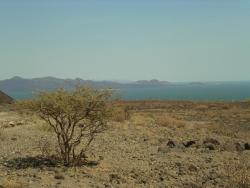
A view of the Lake Turkana environment as it exists today. AdamPG, Wikimedia Commons
|
Animals, not drought, shaped our ancestors' environment
26 June 2017
The shores of Lake Turkana, in Kenya, are dry and inhospitable, with grasses as the dominant plant type. It hasn't always been that way. Over the last four million years, the Omo-Turkana basin has seen a range of climates and ecosystems, and has also seen significant steps in human evolution. Scientists previously thought that long-term drying of the climate contributed to the growth of grasslands in the area and the rise of large herbivores, which in turn may have shaped how humans developed. It's tough to prove that hypothesis, however, because of the difficulty of reconstructing four million years of climate data.
Researchers from the University of Utah have found a better way. By analyzing isotopes of oxygen preserved in herbivore teeth and tusks, they can quantify the aridity of the region and compare it to indicators of plant type and herbivore diet. The results, published in a study issued through the Proceedings of the National Academy of Sciences (PNAS) show that, unexpectedly, no long-term drying trend was associated with the expansion of grasses and grazing herbivores. Instead, variability in climate events, such as rainfall timing, and interactions between plants and animals may have had more influence on our ancestors' environment. This shows that the expansion of grasslands isn't solely due to drought, but more complex climate factors are at work, both for modern Africans now and ancient Africans in the Pleistocene.
Source: http://popular-archaeology.com/issue/summer-2017/article/animals-not-drought-shaped-our-ancestors-environment
|
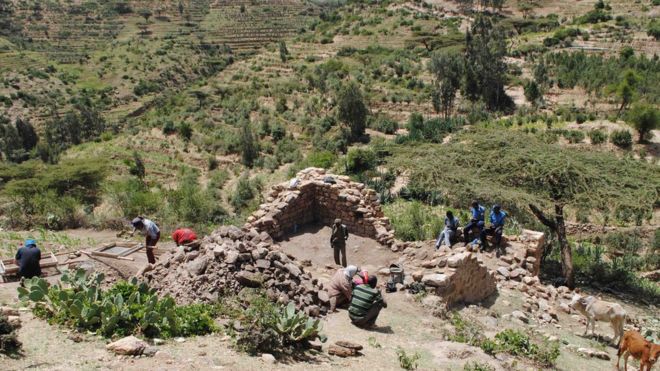
These are the remains of a 12th Century mosque
|
Archaeologists in Ethiopia uncover ancient city in Harlaa
16 June 2017
A forgotten city thought to date back as far as the 10th century AD has been uncovered by a team of archaeologists in eastern Ethiopia.
Artefacts from Egypt, India and China have been found in the city in the Harlaa region.
The archaeologists also uncovered a 12th Century mosque which is similar to those found in Tanzania and Somaliland.
Archaeologists says this proves historic connections between different Islamic communities in Africa.
"This discovery revolutionises our understanding of trade in an archaeologically neglected part of Ethiopia. What we have found shows this area was the centre of trade in that region," lead archaeologist Professor Timothy Insoll from the University of Exeter said.
The team also found jewellery and other artefacts from Madagascar, the Maldives, Yemen and China.
Harlaa was a "rich, cosmopolitan" centre for jewellery making, Prof Insoll said.
"Residents of Harlaa were a mixed community of foreigners and local people who traded with others in the Red Sea, Indian Ocean and possibly as far away as the Arabian Gulf," he said.
'City of giants'
BBC Ethiopia correspondent Emmanuel Igunza says there was a local myth that the area was occupied by giants because the settlement buildings and walls were constructed with large stone blocks that could not be lifted by ordinary people.
However the archaeologists found no evidence of this.
"We have obviously disproved that, but I'm not sure they fully believe us yet," said Prof Insoll.
A statement from the team says the remains of some of the 300 people buried in the cemetery are being analysed to find out what their diet consisted of.
Further excavations are expected to be conducted next year.
A religious crossroads
Ethiopia was one of the earliest places known to be inhabited by humans. In 2015 researchers discovered jaw bones and teeth in the north-west of the country dating to between 3.3m and 3.5m years old.
Coptic Christianity was introduced from Egypt and was adopted as the religion of the Kingdom of Aksum in 333 AD. The Ethiopian church maintains that the Old Testament figure of the Queen of Sheba travelled from Aksum in northern Ethiopia to visit King Solomon in Jerusalem.
Islam arrived in Ethiopia in the 7th Century as early Muslim disciples fled persecution in Mecca. The main seat of Islamic learning in Ethiopia was Harar, which is located near Harlaa. Harar is said to be among the holiest Islamic cities and has 82 mosques, including three dating from the 10th Century, and 102 shrines, according to Unesco.
Today there are about 30m Christians and 25m Muslims in the country, according to 2007 census figures.
Source: http://www.bbc.com/news/world-africa-40301959
|
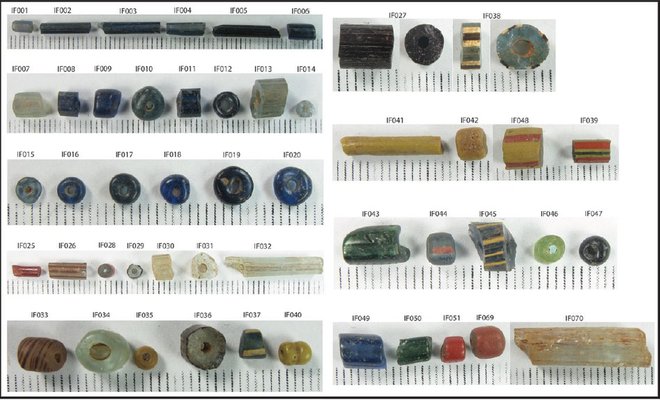
Researchers found glass beads of all colors in the ancient city of Ile-Ife. Credit: Babalola, A.B.
|
1,000-Year-Old Colored Glass Beads Discovered in West Africa
13 June 2017
A newly discovered treasure trove of more than 10,000 colorful glass beads, as well as evidence of glassmaking tools, suggests that an ancient city in southwestern Nigeria was one of the first places in West Africa to master the complex art of glassmaking, scientists reported.
The finding shows that people who lived in the ancient city of Ile-Ife learned how to make their own glass using local materials and fashion it into colorful beads, said study lead researcher Abidemi Babalola, a fellow at Harvard University's Hutchins Center for African & African American Research.
"Now we know that, at least from the 11th to 15th centuries [A.D.], there was primary glass production in sub-Saharan Africa," said Babalola, who specializes in African archaeology.
Ancient city of IIe-Ife
The ancient city of Ile-Ife was the ancestral home of the Yoruba, an ethnic group of people who live in Africa today. The Yoruba people view Ile-Ife as the mythic birthplace of several of their deities, Babalola and his colleagues wrote in the study.
Ile-Ife is also widely known for its copper alloy and terracotta heads and figurines that were made between the 12th and 15th centuries A.D., the researchers said.
Some of the figurines are decorated with glass beads on their headdresses, crowns, necklaces, armlets and anklets, the researchers said. Moreover, archaeologists have found glass beads at Ile-Ife's ancient shrines and within unearthed crucibles - ceramic containers that were used to melt glass.
Where did these glass beads come from? Most researchers speculated that the beads arrived from afar through trade, possibly from the Mediterranean area or the Middle East, and that artisans in Ile-Ife used crucibles to melt and refashion some of them into new beads, Babalola told Live Science.
But Babalola and a handful of other researchers suspected that the answer was closer to home. To find out, Babalola traveled to Igbo-Olokun, an archaeological site within Ile-Ife, and excavated several places from 2011 to 2012, searching for evidence of local glass production, he said.
Babalola discovered a treasure trove during the excavation, finding almost 13,000 beads, 812 crucible fragments, 403 fragments of ceramic cylinders (rods that were possibly used to handle the crucible lids), almost 7 lbs. (3 kilograms) of glass waste and about 14,000 potsherds, the researchers wrote in the study.
Babalola didn't find any furnaces that would have helped artisans heat the crucibles, but "the abundance of glass-production debris and the presence of vitrified clay fragments [clay with melted glass on it] indicate, however, that these areas were in, or very near, a zone of glass workshops," the researchers wrote in the study.
The majority of the beads are less than 0.2 inches (5 millimeters) across, and are colored blue, green, red, yellow or multicolored, Babalola said.
The researchers found that many of the beads, primarily the blue ones, were made "almost exclusively" from materials that are found near Igbo-Olokun, they wrote in the study. For instance, these beads had a high aluminum-oxide (also known as alumina) content, and previous researchers have pointed out that there are high-alumina sand deposits near Ile-Ife, Babalola said.
What's more, artisans might have used local ingredients, such as feldspar, to lower the heating temperature needed to melt glass in the crucibles, he said.
Glass world
The beads Babalola and his colleagues studied are called drawn beads, meaning artisans used a special technique that included using an air bubble to make the beads' holes. Craftspeople in India were making drawn glass beads as early as the fourth century B.C., but given the distance between India and modern-day Nigeria, Babalola and his colleagues propose that the West Africans developed the technique independently, he said.
However, more research is needed to support this claim, Babalola noted.
After the West African people made these beads, they traded them far and wide. Beads with the same components have been found in the upper Senegal region, including in Mali, and along the Niger River, the researchers wrote in the study.
The findings also show that West Africans were more technologically advanced than previously thought, Babalola said.
"We are talking about very sophisticated crafts," he said. "It takes someone who knows what he is doing and someone who has a very good understanding of science and technology to make this glass."
The study was published in the June issue of the journal Antiquity.
Source: https://www.livescience.com/59462-early-glassmaking-west-africa.html
|
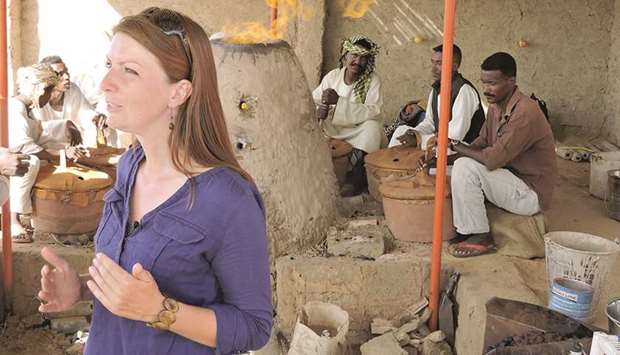
Dr Humphris with workers at the UCL Qatar Iron and Kush Information Point in Sudan
|
Archaeological dig in Sudan unearths 'many exciting finds'
12 June 2017
When UCL Qatar archaeologist Dr Jane Humphris returns to work in the ancient city of Meroe, Sudan, later this year, she says it will feel like "going home".
Dr Humphris, who heads UCL Qatar's Sudan archaeology project, has been overseeing investigations into ancient iron production associated with Meroe, part of the Kingdom of Kush, for the last five years.
During this time, the UCL Qatar team has unearthed many exciting archaeological finds, been instrumental in involving the local community in work at Meroe, provided dedicated training to many Sudanese graduates and, earlier this year, opened the 'UCL Qatar Iron and Kush Information Point' for visitors to learn about the technological history of the area.
"You really start to become part of the local family out there," said Dr Humphris. "Over the years we've built a 'dig house' for the team at Meroe. So now, when I'm driving out to the village where our site is, it's like going home, and the people living in the area are like a big extended family."
While Meroe has been known as an ancient iron production centre for around 100 years, very little archaeology research had been done in relation to the metallurgical remains in the area until the UCL Qatar project, backed by Qatar Foundation (QF), began excavating in 2012.
"We've found very early iron production at the site as well as later iron works," said Dr Humphris, who explained that Meroe was the second capital of the Kingdom of Kush, which was a powerful African state from roughly 800BC to 350AD.
When the UCL Qatar team discovered an ancient iron production and furnace workshop at Meroe in 2014, it gave rise to the idea to build an Information Point at the site. "This was a great opportunity for us to think about doing experimental archaeology; because the best way to understand an ancient technology is to try to do it yourself."
Dr Humphris' team built a replica of the furnace workshop next to the biggest iron remains at Meroe. "We built the furnace and it worked, so we staged the area as if we'd just been smelting and developed information panels on the Kingdom of Kush, the Royal City of Meroe, as well as iron production and its importance. The idea is that people can go there anytime and learn about the site."
Dr Humphris, who has worked as an Africanist archaeologist with a specialism in iron production for more than 15 years, divides her time between working in the field in Sudan, and in the labs and at her office at UCL Qatar in Education City, Doha.
"One of the great things about being an archaeologist is that you never know what you're going to find. Every little thing we find in our trenches has the potential to be an exciting breakthrough," she said.
Like any successful archaeological project, UCL Qatar's Sudan research is dependent on the analysis of samples taken from the site. Through its collaboration with the Sudan National Corporation for Antiquities and Museums, the team has been able to bring a wide range of samples back to the material science labs in Doha for analysis.
"We've had some really nice object finds, nothing like gold or treasure, but things like a figurine that could have been a child's toy, and huge quantities of pottery that help us to examine what people might have been eating or drinking. I really like finding things that bring the human aspect into the archaeology we’re excavating."
Dr Humphris describes the labs at UCL Qatar as "almost unparalleled" in the region. "The analysis we carry out on samples here allows us to recreate and tell the story of the past. The facilities QF provides are very impressive; and it goes beyond the labs to the libraries. I’m running a project from Sudan and Qatar and we have the most amazing library at our disposal that covers everything from museums to database management to conservation."
The head of UCL Qatar research in Sudan says she is looking forward to returning to Meroe for 12 weeks from the start of October. "I always look forward to getting back to Meroe. When we're not in the field, we're busy doing analysis in Doha, so by the time we return, our understanding of everything has developed so much that we can move forward with the research questions we want to ask for our up-coming field season," she said.
Source: http://www.gulf-times.com/story/553025/Archaeological-dig-in-Sudan-unearths-many-exciting
|

The "prehistoric"
landscape of the
Sabaloka Mountains,
near the archaeological site. Petr Pokorný, 2014
|
Sudan: Mysterious holes drilled in rocks are remains of ancient shelters on the banks of the Nile River
12 June 2017
Mysterious man-made holes in rocks located on the west bank of the River Nile could be the remains of an ancient extinct type of architecture created thousands of years ago, archaeologists have said.
Working at the site of Sphinx, in central Sudan, researchers have associated these strange features with wooden pole-built structures which probably served as shelters for the people living there sometime during the Mesolithic era (between 9000 and 5000 BCE), or later.
Unusual man-made features in the rocks of North Africa are often reported during rock art surveys, but archaeologists have so far devoted little attention to them.
The study now published in the journal Antiquity focuses on a series of holes found in granite rocks. Although these rocks have been affected by natural processes over the years, these particular holes stand out.
"These holes are clearly man-made as their regular shapes and diameters suggest, they are different from natural features that appear with the weathering of the rocks. One of the first questions we get when we present the paper is how these holes were drilled," one of the study's authors, Lenka Varadzinová, a researcher at the Czech Institute of Egyptology, told IBTimes UK.
"Metal was probably not involved in the process as we find no traces of it. We can't be sure of the method used to create the holes, but what is certain is that it would have been a hell of a job, a long term investment done over a long period of time with the intention of being fixed to the place"
Experimental reconstruction
The archaeologists describe the holes saying they have a regular cylindrical shape with visibly smooth sides, a diameter of between 40 and 50 mm, and a pointed end. They are positioned at a height of about 1.3 to 3.2 metres above the present-day ground surface.
While these holes could be sign of ancient rituals associated with magic and spirituality, no firm evidence backs this up. Instead, the archaeologists believe that they were made to fulfill a more practical function. In the paper, they investigate this hypothesis further.
During the 2015 excavation season, the archaeologists obtained detailed measurements of the holes. Along with photogrammetry, 3D models and photographs, these measurements were used to carefully document the holes and the rock walls.
The team then used the data to come up with a hypothetical reconstruction of two structures which would have been firmly anchored to the rocks and supported by pliable wooden poles made of branches or roots - one end of which was inserted into the holes in the rock.
In this model, the holes, painstakingly drilled over a long period of time, form the basis for the construction of huts anchored to the rocks, where ancient people would have lived.
"There is no certainty in archaeology, we just present a hypothesis of what the structures might have looked like. The hypothesis is based on scientific reconstruction, which is based on all the data recorded at the site," Varadzinová explained.
"These ancient people had to live somehow, and since there are so few architectural remains from the past in the North East of Africa, these holes constitute another type of finds that, we believe, one can associate with them.
"These shelters would have been anchored to the rocks for solidity and to keep them in the shade throughout all day, but also because there wasn't that much space at the settlement platform set in the rocky landscape, and otherwise putting a hut in the middle of it would have left little space for other activities."
Just like dating rock art often proves difficult, linking these holes to a precise time period is challenging. Archaeologists have to rely on finds of artefacts that have previously been made in the area. At the site of Sphinx, most artefacts date back to the Khartoum Mesolithic era (c.9000-5000BC) although a couple of objects date back to later periods - the Meroitic (c. 300 BCE-350 CE) or Post-Meroitic (c. 350-550 CE) and Funj (c. 1500-1800 CE) periods.
Since the authors cannot say for certain which of these time periods the holes relate to, little can be said about the culture of the people who created them. But whether they were early hunter-gatherers and later pastoralists, they would have found refuge in pole-built structures similar to the ones modelled in the paper, light and practical for a nomadic or semi-nomadic lifestyle.
Source: http://www.ibtimes.co.uk/sudan-mysterious-holes-drilled-rocks-are-remains-ancient-shelters-banks-nile-river-1625878
|
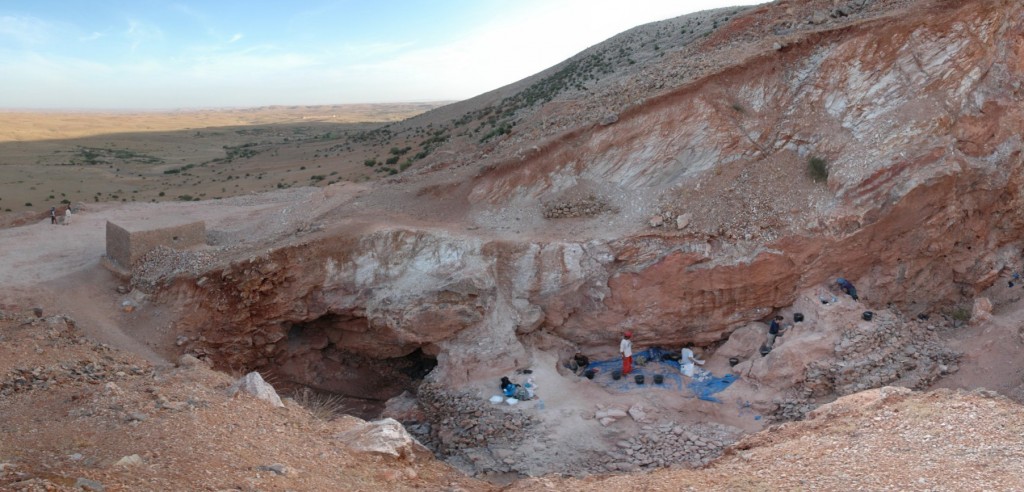
Picking up where earlier archaeologists left off at
the site of Jebel Irhoud
in Morocco, an
international scientific
team reports that it has
found fossil remains of
the earliest known
Homo sapiens. Photo by Shannon McPherron, MPI EVA Leipzig
|
Homo Sapiens Just Got Older - Way, Way Older
7 June 2017
Bones found in Morocco place our lineage 100,000 years earlier and nowhere near where we thought.
In 1961, miners digging into a promontory in Morocco, some 50 kilometers from the Atlantic Ocean, discovered something very unexpected - a handful of stone tools and an ancient, nearly complete human skull. Eager to learn more, archaeologists proceeded to excavate the site, known as Jebel Irhoud, uncovering five more fossil human bones, as well as dozens of flint tools thought to have been made by Neanderthal hunters. Based on these finds and the methods of archaeological dating available at the time, researchers concluded in the 1960s that Jebel Irhoud's inhabitants were African Neanderthals who roamed the region 40,000 years ago.
Flash forward to 2017. In two papers published today in the journal Nature, paleoanthropologist Jean-Jacques Hublin of Max Planck Institute for Evolutionary Anthropology in Germany and his colleagues report that bones from Jebel Irhoud date to around 300,000 years ago, and shed new light on the origins of our species, Homo sapiens. The human occupation at the site, says Hublin, coincides with the beginning of the Middle Stone Age, and may extend the story of our H. sapiens ancestors by 100,000 years. Jebel Irhoud's humans, he adds, are "the oldest Homo sapiens ever found in Africa or elsewhere."
The scientific team decided to reopen excavations at Jebel Irhoud in 2004 in hopes of obtaining a new series of dates for the site using advanced archaeological dating methods. In a surviving part of the site, the team discovered 16 more fossil human bones, as well as remains of prey animals, such as gazelles, zebras, and wildebeests. In addition, the researchers found evidence of fire in the oldest layers, along with several burned stone tools. These heated tools allowed the team to date the layer richest in fossil human bones using a well-accepted technique known as thermoluminescence dating.
Located some 50 kilometers from the Atlantic coast, the site of Jebel Irhoud in Morocco was inhabited during a wetter period than today. Ancient humans at the site hunted gazelles, zebras, and wildebeests. Illustration by Mark Garrison
Hublin says the fossil human bones found at Jebel Irhoud belonged to at least five individuals-three young adults, one adolescent, and a child about eight years old. "The faces of these people would have been short, flat, and retracted," says Hublin. "It's the face of people that you cross in the street today." Even so, the humans at Jebel Irhoud would have had a somewhat heavier build than humans today.
And their brains would have been organized differently than ours, Hublin adds. At Jebel Irhoud, for example, the 300,000-year-old braincases - the part of the skull that houses the brain - are elongated in shape and accommodate a larger cerebellum, the part of the brain that plays an important role in maintaining balance, coordinating voluntary movements, and fine-tuning motor skills. Modern humans have a similar overall cranial capacity, but we possess a smaller cerebellum, suggesting that our gray matter is wired in a different way.
Team member Shannon McPherron, an archaeologist at Max Planck Institute for Evolutionary Anthropology, thinks the climatic conditions at Jebel Irhoud would have been somewhat wetter than they are today, based on clues gleaned from the site's faunal record. The landscape would have been green and open, with clumps of trees - a habitat favorable to animals such as gazelles and zebras. The humans who overnighted at Jebel Irhoud, McPherron adds, were hunters armed with what was then the latest stone tool technology - sharp-edged stone flakes likely used as spear tips as opposed to the heavy stone axes or cleavers carried by Early Stone Age humans.
"The overall picture," says McPherron, "is that this is a kind of hunting encampment, where people spent the night and took shelter."
Scientists created a composite reconstruction of the most ancient human skull bones and teeth found at Jebel Irhoud. The facial area looks similar to that of modern humans, but the braincase (shown in blue) has an archaic, elongated shape. Video by Philipp Gunz, MPI EVA Leipzig
Israel Hershkovitz, a paleoanthropologist at Tel Aviv University in Israel who was not a member of the team, thinks that Jebel Irhoud adds an important new piece to our picture of human evolution. He accepts the dating of the site and thinks the team has correctly identified the fossil bones. "I personally believe that it is indeed a remote member of our species," Hershkovitz notes by email.
But other scientists are taking a more cautious view of the findings. Mark Collard, an evolutionary anthropologist at Simon Fraser University in Vancouver, British Columbia, remains to be convinced that these 300,000-year-old humans were part of the lineage that ultimately gave rise to H. sapiens. "I think it’s probably best to view the specimens as adding to our understanding of the variability of Middle Pleistocene hominins," Collard notes by email.
Certainly, the new findings from Morocco are bound to stir much discussion in the scientific community, and many paleoanthropologists hope to see other human fossil bones surface from this critical period in human evolution. "It will be interesting to see how the story unfolds from here as more fossils are found," paleoanthropologist April Nowell at the University of Victoria in British Columbia writes in an email.
Source: https://www.hakaimagazine.com/article-short/homo-sapiens-just-got-older-way-way-older
|
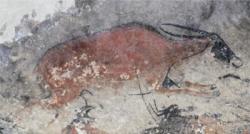
|
New research reveals earliest directly dated rock paintings from southern Africa
1 June 2017
In a study published in the international journal Antiquity, Professor David Pearce, Director of the Rock Art Research Institute at the University of the Witwatersrand, Johannesburg, Adelphine Bonneau of Laval University, and colleagues at the University of Oxford showed that paintings in south-eastern Botswana are at least 5,500 years old, whilst paintings in Lesotho and the Eastern Cape Drakensberg, South Africa, date as far back as 3,000 years. These dates open the floodgates for researchers to ask and answer questions about the rock art that have baffled them for decades.
The dates obtained show some surprising results. In some sites, paintings continued to be made for more than a thousand years. "This is astonishing," says Pearce, "people returned to the same rock shelters over very long periods of time to make rock paintings very similar to those made centuries or millennia before. This finding has profound implications for our understanding of hunter-gatherer religion in southern Africa."
Research was conducted in the Thune Dam in Botswana, the Metolong Dam area in the Phuthiatsana Valley of Lesotho, and the Drakensberg Escarpment of the Eastern Cape in the 'Nomansland' region of South Africa. A total of 43 new dates were produced from these three areas, including the first direct dates on rock paintings ever in Botswana and Lesotho.
The new dates were obtained using radiocarbon dating. Over the decades rock art has proved extremely difficult to directly date. Indeed, it has been a major obstacle in this area of research. The success of this project is based on very careful chemical characterisation of the composition of the paint and contaminants on the rock. New chemical techniques were developed to remove contaminants from small samples of paint. These could then be dated using accelerator mass spectrometry (AMS) radiocarbon dating.
The two-phase research project entailed collecting tiny (less than a millimetre squared) quantities of pigment from the rock painting and then analysing these samples to determine which art should be sampled for AMS radiocarbon dating. The samples that contained the most carbon-black (and thus most likely to reveal dates) were then radiocarbon dated.
The dates reported in this study form the biggest set of direct dates on rock art in South Africa and the only direct dates ever obtained in Botswana and Lesotho.
Lead author, Bonneau, concludes in the paper: "This protocol is a step forward in the field of rock art dating by reducing the sample size to be collected, by optimising the success rate of such dating, and by limiting the impact on such valuable paintings while providing new chronological insights."
Source: http://popular-archaeology.com/issue/spring-2017/article/new-research-reveals-earliest-directly-dated-rock-paintings-from-southern-africa
|
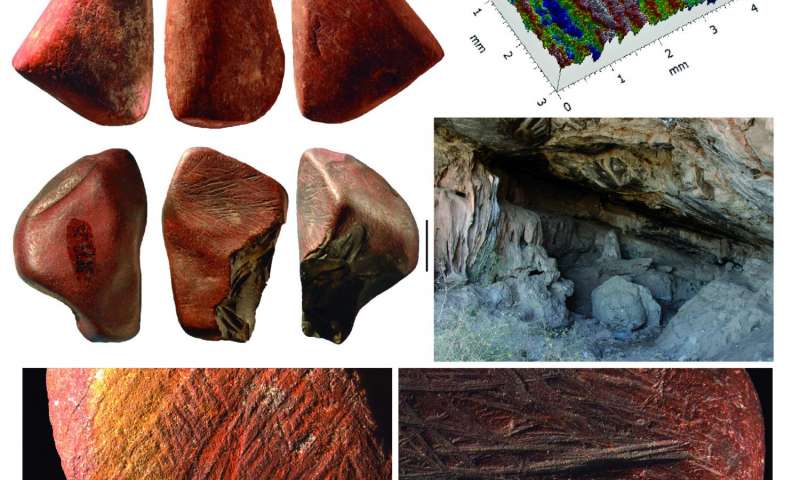
Images of ochre, the
iron-rich rock
characterized by a red
or yellow color, that was found at many Middle
Stone Age sites. Credit: Rosso et al (2017)
|
Ochre use by Middle Stone Age humans in Porc-Epic cave persisted over thousands of years
24 May 2017
Middle Stone Age humans in the Porc-Epic cave likely used ochre over at least 4,500 years, according to a study published May 24, 2017 in the open-access journal PLOS ONE by Daniela Rosso from the University of Barcelona, Spain, and the University of Bordeaux, France, and colleagues.
Ochre, an iron-rich rock characterized by a red or yellow color, is found at many Middle Stone Age sites. The largest known East African collection of Middle Stone Age ochre, found at Porc-Epic Cave in Ethiopia, weighs around 40kg and is thought to date to ca. 40,000 years ago. The authors of the present study conducted a detailed analysis of 3792 pieces of ochre, using microscopy and experimental reproduction of grinding techniques to assess how the ochre was processed and used over a 4,500-year timespan.
The researchers found that the cave inhabitants appeared to have persistently acquired, processed, and used the same types of ochre during this period.
Overall the inhabitants of the cave seem to have processed almost half of the ochre pieces, although the proportion of ochre which had been modified decreased progressively over the period. Whilst flaking and scraping of ochre pieces appeared to have become more common over time, the authors noted a reduction in the proportion of pieces which underwent grinding. The gradual nature of shifts in preferred processing techniques may indicate that they resulted from cultural drift within this practice.
Intensively modified ochre pieces show ground facets likely produced with different types of grindstones, at different times. According to the authors, these pieces were probably curated and processed for the production of small amounts of ochre powder. This is consistent with use in symbolic activities, such as the production of patterns or body painting, although a use for utilitarian activities cannot be discarded.
Whilst the increase of ochre use in certain layers could be explained by refining the dating of the sequence and acquiring environmental data, these authors state that their analysis of ochre treatment seems to reflect a "cohesive behavioral system shared by all community members and consistently transmitted through time."
Source: https://phys.org/news/2017-05-ochre-middle-stone-age-humans.html
|
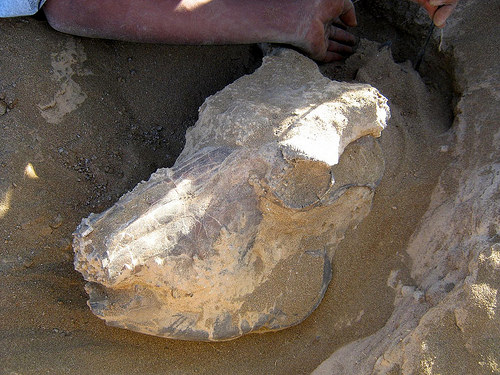
A wildebeest fossil skull
excavated at the
Ledi-Geraru research site,
Ethiopia. Credit: Josh
Robinson
|
Grassy beginning for earliest Homo
15 May 2017
In 2013, an ASU research team found the oldest known evidence of our own genus, Homo, at Ledi-Geraru in the lower Awash Valley of Ethiopia. A jawbone with teeth was dated to 2.8 million years ago, about 400,000 years earlier than previously known fossils of Homo. After the discovery, attention turned to reconstructing the environment of this ancient human ancestor to understand why there and why then.
But how do you re-create specific environments from millions of years ago to understand where our ancient ancestors lived?
Paleoanthropologists use animal fossils like proxy time machines to re-create what past environments were like. If animal fossils indicate browsing on tree leaves, like giraffes and monkeys do, then they know that the environment was characterized by woody trees and significant rainfall. If the fossils suggest grazing on grass, as many antelopes do, then the environments would have been open and arid with grassy plains.
Scientists have long suggested that global cooling and the spread of grassy environments set the stage for the beginnings of Homo.
"A growing body of evidence has hinted at this connection," said Joshua Robinson, postdoctoral researcher with the Institute of Human Origins, "but, until now, we had no direct environmental data for the origins of Homo now that its been pushed back in time."
Following the discovery of the Ledi-Geraru jaw, an intensive environmental study of the eastern African Plio-Pleistocene--from around 3.5 million years ago to 1.0 million years ago--was conducted in order to investigate these long-standing hypotheses.
The study, coauthored by ASU researchers Joshua Robinson, John Rowan, Christopher Campisano and Kaye Reed with University of South Florida researcher Jonathan Wynn, in the journal Nature Ecology and Evolution, offers the first comprehensive assessment of the ecological contexts of the transition from Australopithecus to Homo.
The time period around 2.8 million years ago is particularly important for the human fossil record of eastern Africa. Thirty kilometers to the west of Ledi-Geraru is Hadar, where the famous "Lucy" fossil of Australopithecus afarensis was found in 1974 by ASU professor Donald Johanson and dated to 3.2 million years ago. The geological sequence at Hadar, however, ends around 2.95 million years ago and is thus missing the important transitional period between the end of Australopithecus and earliest Homo.
Using stable isotopes of fossil teeth, the researchers found that early Homo at Ledi-Geraru was indeed associated with open and arid grassy environments. Results show that almost all animals found with early Homo at Ledi-Geraru fed on grass, including some that consumed substantial amounts of tree leaves prior to 2.8 million years ago. The diet of early Homo at Ledi-Geraru, however, appears to be indistinguishable from that of the earlier Australopithecus, implying that a change in diet is not a characteristic of the origins of Homo.
"We weren't necessarily surprised that the diet of early Homo was similar to Australopithecus," said Chris Campisano, research associate with the Institute of Human Origins and associate professor in the School of Human Evolution and Social Change. "But we were surprised that its diet didn't change when those of all the other animals on the landscape did."
Placing Ledi-Geraru in a regional context indicates that eastern Africa environments at this time were not homogeneous. The ecology of the lower Awash Valley shifted from a wet and wooded environment at the time of the disappearance of Australopithecus around three million years ago to a dry and open landscape at the time of early Homo 2.8 million years ago.
"Although Lucy's species persisted through many environmental changes in the Hadar sequence," School of Human Evolution and Social Change graduate student John Rowan said, "it seems the species was unable to persist as really open environments spread in the Afar during the late Pliocene."
Furthermore, these results indicate that the spread of grassy environments at Ledi-Geraru occurred earlier than in the Turkana Basin of Kenya and Ethiopia, which continued to have wooded regions that supported browsers and other mammals that fed on both trees and grasses.
"By using several different habitat proxies, we were able to refine previous ecosystem reconstructions in each basin so that we were able to identify the details of the spread of grasslands," said Kaye Reed, President's Professor and director of the School of Human Evolution and Social Change. Reed is also a research associate with the Institute of Human Origins. "We are planning to compare other East African hominin sites using these same methodologies."
Source: http://popular-archaeology.com/issue/spring-2017/article/grassy-beginning-for-earliest-homo
|
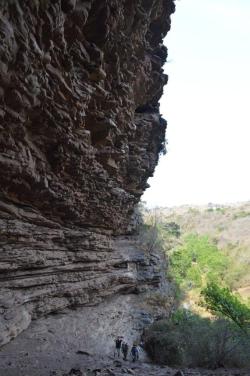
Sibudu Cave is a rock
shelter in a sandstone
cliff in northern KwaZulu-
atal, South Africa. It is an
important Middle Stone
Age site occupied, with
some gaps, from 77,000
years ago to 38,000 years
ago. Text and image
credit: DarkaRolandStark,
Wikimedia Commons
|
Early evidence of Middle Stone Age projectiles found in South Africa's Sibudu Cave
26 April 2017
Innovations in stone knapping technology during the South African Middle Stone Age enabled the creation of early projectile weapons, according to a study published April 26, 2017 in the open-access journal PLOS ONE by Veerle Rots from University of Liège, Belgium, and colleagues.
The South African Middle Stone Age (MSA) is considered a period of major technological advancement, with hunter-gatherers introducing new manipulative techniques using heat and pressure to create stone projectile weapons. However, the timing and location of these developments is a topic of much debate.
The authors of the present study examined 25 weapon point fragments excavated from the Sibudu Cave site, analyzing their technological and functional differences and comparing them with reference samples produced for the purpose by an experienced knapper. Some of the points had two faces, a likely result of applying pressure to both sides. Some had serrations, or jagged edges, that were likely produced by a technique known as pressure flaking.
The researchers found that 14 of the 25 point fragments bore evidence of impact-related damage, animal residues, and wear features that strongly indicated that these points may have been used for hunting. Examination of the impact-related fractures and the distribution of the points indicated that these points may have been attached to handles to form projectile weapons and that these weapons were projected from a distance, most likely with a flexible spear-thrower or a bow.
While further research would help to confirm the timeline and development of stone knapping techniques, the new Sibudu Cave site data may push back the evidence for the use of pressure flaking during the MSA to 77,000 years ago. The authors note that these findings highlight the diversity of technical innovations adopted by southern African MSA humans.
Source: http://popular-archaeology.com/issue/spring-2017/article/early-evidence-of-middle-stone-age-projectiles-found-in-south-africa-s-sibudu-cave
|
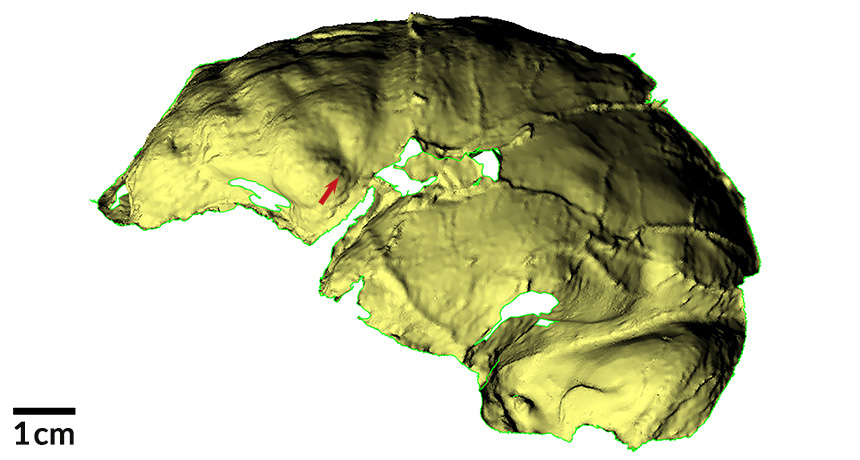
Go for Broca. A virtual
cast of Homo naledi's
brain surface contains
clues to the presence of
a region (pointed to by
red arrow) that may
correspond to Broca's
area in present-day
people. This language-
related neural region
enhanced social
emotions and
communication in the
still-undated southern
African Homo species, researchers contend
|
Homo naledi's brain shows humanlike features
25 April 2017
A relatively small brain can pack a big evolutionary punch. Consider Homo naledi, a famously puzzling fossil species in the human genus. Despite having a brain only slightly larger than a chimpanzee's, H. naledi displays key humanlike neural features, two anthropologists reported April 20 at the annual meeting of the American Association of Physical Anthropologists.
Those brain characteristics include a region corresponding to Broca's area, which spans parts of the right and left sides of the brain in present-day people. The left side is typically involved in speech and language.
"It looks like Homo naledi's brain evolved a huge amount of shape change that supported social emotions and advanced communication of some type," said Shawn Hurst of Indiana University Bloomington, who presented the new findings. "We can't say for sure whether that included language." Frontal brain locations near Broca's area contribute to social emotions such as empathy, pride and shame. As interactions within groups became more complex in ancient Homo species, neural capacities for experiencing social emotions and communicating verbally blossomed, Hurst suspects.
Scientists don't know how long ago H. naledi inhabited Africa's southern tip. If H. naledi lived 2 million or even 900,000 years ago, as some researchers have suggested (SN: 8/6/16, p. 12), humanlike brains with a language-related area would be shocking. A capacity for language is thought to have emerged in Homo over the last few hundred thousand years at most.
Discoverers of H. naledi, led by anthropologist Lee Berger of the University of the Witwatersrand in Johannesburg, will announce an estimated age for the species and describe new fossil finds within the next few weeks, Hurst said.
Hurst and Ralph Holloway of Columbia University led a team that laser scanned the inside surfaces of several partial H. naledi skulls to create virtual casts, or endocasts, of brain surfaces. An endocast reproduces the shape and, with varying success, details of the surface of the brain that were imprinted on the walls of the braincase while an individual was alive. Such brain impressions are not always clear, which has sparked debate over how to interpret them.
Two grooves identified on an endocast from a partial H. naledi skull frame the language-related section of Broca's area in humans today, Hurst said. H. naledi's brain also possessed folds of tissue that largely covered a surface section where the grooves converged. Similar folds of tissue typically cover the surface of Broca's area in modern human brains.
The general shape of that part of the frontal brain in humans differs greatly from that of living apes and fossil hominids dating to at least 700,000 to 1 million years years ago, Hurst added.
H. naledi also displays a humanlike pattern of surface features at the back of the brain, although to a lesser extent than at the brain's front, Holloway said. Endocasts for this analysis came from two other partial H. naledi skulls.
Specific protrusions and other features at the back of H. naledi's brain are more pronounced on the left side, Holloway said. In people today, the same left-sided bias in brain organization is associated with right-handedness.
In the past, Holloway and anthropologist Dean Falk of Florida State University in Tallahassee have sharply disagreed over how to identify neural features on fossil endocasts, including a key groove in tissue at the back of the brain. After hearing Hurst and Holloway's presentations, Falk expressed doubt that H. naledi's brain was as humanlike as they concluded.
Shortly after the presentations, Hurst and Falk hashed out their differences head-to-head as they jointly studied a solid cast of the partial H. naledi brain surface displaying proposed signs of Broca's area. They agreed on much about the fossil species' neural setup, with one major exception. "I'm skeptical that two frontal [grooves] frame an area that corresponds to Broca's area," Falk said. If she's right, then H. naledi communicated much less like present-day people than proposed by Hurst. Falk plans to study the new endocasts more closely and compare them with endocasts of other fossil hominids.
Source: https://www.sciencenews.org/article/homo-naledis-brain-shows-humanlike-features
|
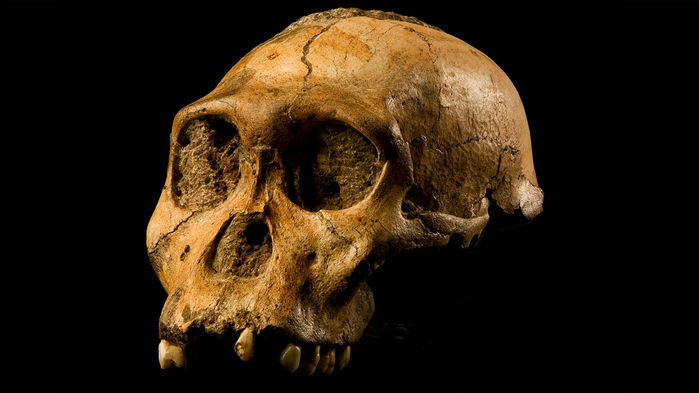
This skull may have
grown up to look more
like an australopithecine than a human-like
member of our genus
Homo
|
A famous 'ancestor' may be ousted from the human family
23 April 2017
A remarkably complete skeleton introduced in 2010 as "the best candidate" for the immediate ancestor of our genus Homo may just be a pretender. Instead of belonging to the human lineage, the new species of Australopithecus sediba is more closely related to other hominins from South Africa that are on a side branch of the human family tree, according to a new analysis of the fossil presented here last week at the annual meeting of the American Association of Physical Anthropologists.
When fossils from several individuals' skeletons were found in a collapsed cave in Malapa, South Africa, in 2008, their discoverer, paleoanthropologist Lee Berger of the University of the Witwatersrand, noted that they helped fill a key gap in the fossil record 2 million to 3 million years ago when some upright-walking australopithecine evolved into the earliest member of our genus, Homo. But the oldest Homo fossils, at 2.4 million to 2.9 million years, are scrappy, and a half dozen more primitive hominins may have been walking around Africa at roughly the right time to be the ancestor. Researchers have hotly debated whether their direct ancestor was the famous 3.2-million-year-old fossil Lucy and her kind, Australopithecus afarensis from Ethiopia, or another australopithecine.
With its fossils dated to 1.98 million years ago, Au. sediba is too young to be directly ancestral to all members of the genus Homo. But Berger and his colleagues proposed in 2010, and again in 2013 in six papers in Science, that given the many humanlike traits in Au. sediba's face, teeth, and body, the Malapa fossils were a better candidate than Lucy or other East African fossils to be ancestral to Homo erectus, a direct human ancestor that appeared 1.8 million years ago.
In a talk here, though, paleoanthropologist Bill Kimbel of Arizona State University in Tempe analyzed the most complete skull of Au. sediba and systematically shot down the features claimed to link it to early Homo. Kimbel noted that the skull was that of a juvenile—a "7th grader" - whose face and skull were still developing. In his analysis, with paleoanthropologist Yoel Rak of Tel Aviv University in Israel, he concluded that the child already showed traits that linked it most closely to the South African australopithecine Au. africanus, a species that lived in South Africa 3 million to 2.3 million years ago. And had it survived to adulthood, its humanlike facial traits would have changed to become even more like those of Au. africanus.
For example, the breadth of the young Au. sediba's cheekbones appears narrow, as in early Homo. But by studying other australopithecine, ape, and Homo fossils to see how features of the cheekbones change as individuals grow and chewing muscles develop, Kimbel and Rak could predict how the boy's face and skull would have looked if he'd grown up to be an adult. The resemblance to Au. africanus is so striking, in fact, that Kimbel thinks Au. sediba is a closely related "sister species" of Au. africanus - and not a long-lost human relative. "We don't believe that Au. sediba has a unique relationship to the genus Homo," says Kimbel.
Other researchers who have long been skeptical that Au. sediba was an ancestor of Homo found Kimbel's talk persuasive: "Spot on," says paleoanthropologist Bernard Wood of George Washington University in Washington, D.C. Paleoanthropologist Ian Tattersall of the American Museum of Natural History in New York agrees with Kimbel that Au. sediba is most closely related to Au. africanus and that neither species is ancestral to early Homo.
But paleoanthropologist Darryl de Ruiter of Texas A&M University in College Station, a co-author with Berger on the 2013 paper describing the skull, says he and his former graduate student reached "the opposite conclusion" when they used computational methods to project how the skull would have changed as it matured. "I disagree with his impression that the changes that [the skull] would have undergone had it lived to adulthood would be so extensive as to make it appear like Au. africanus," said de Ruiter, who heard Kimbel's talk.
The only way to know what an adult Au. sediba's skull and face really looked like, he says, is to find one: "The ultimate resolution of the question must await the long-hoped-for recovery of the adult cranium of Au. sediba."
Source: http://www.sciencemag.org/news/2017/04/famous-ancestor-may-be-ousted-human-family
|
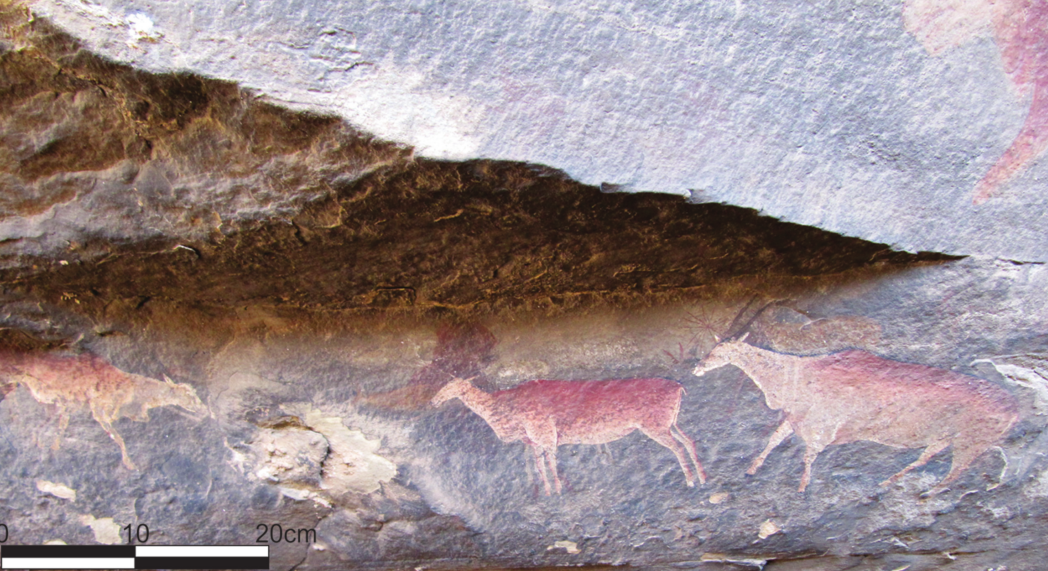
Example of fine-line
Later Stone Age
paintings studied by the archaeologists - Bonneau/Antiquity
|
Earliest dated rock art in Southern Africa depicts shamans' journey to the world of the spirits
5 April 2017
For years, archaeologists have known that southern Africa is home to very rich and well-understood rock art produced by hunter-gatherers in the Later Stone Age, but they had been unable to date these creations precisely.
Using an innovative approach, researchers have now come up with new dates, which suggest that in south-eastern Botswana, rock art was created as far back as 5723-4420 cal BP - the oldest such evidence found to date in Southern Africa. Their complete findings are now published in the Journal Antiquity.
Hunter-gatherer rock art in Southern Africa is made up both of paintings and engravings, which were produced by ancient communities associated with the present-day San (bushmen) culture. A lot of research has been successfully conducted about how to interpret this art.
"Thanks to studies conducted between the 18th and 20thby the Dutch and British settlers as well as current ethnographic research, we have a good understanding of San rock art. They painted to represent what the Shamans had seen during their journeys in the world of the spirits so that the rest of the population could see it", lead author Adelphine Bonneau, post-doctoral fellow at Laval University (Canada), told IBTimes UK.
"They also thought that rocks represented a veil between the world of humans and the spiritual world, and so rock art was thought to help them communicate with the spirits".
Despite these interesting insights, researchers have been limited in their work by the impossibility to accurately and directly date the artworks.
The difficulty of dating rock art
Dating rock art directly is about coming up with a precise date for when it was created. This often entails taking a piece of the painting out to study it - potentially damaging it.
"With current dating methods, we need large samples - sometimes hundreds of milligrams of painting - which often means completely destroying these artworks. We also have to consider that in many cases, the art wasn't protected inside caves and rock shelters but created on outdoors rocks exposed to the elements and to human activity, which means that paintings are often in a bad state and cannot be dated", Bonneau explained.
The most common dating method is radiocarbon dating (Carbon-14 dating) but for it to be used, there needs to be traces of carbon in the paintings. Additionally, where charcoal was used to create paintings, there is always the possibility that the artists used charcoal that had been left over from many years before, so the painting may appear older than it really is.
All of these obstacle have made it hard to establish precise dates for rock art found in Southern Africa. Paintings in the Apollo 11 cave in Namibia have been dated to 25,000 years ago, but these results are highly controversial. Elsewhere, archaeologists have only been able to set very broad time constraints.
A new method to date rock paintings
The authors of this study have, for the first time, attempted to date southern African rock art with a technique known as accelerator mass spectrometry (AMS) radiocarbon dating. The idea is to use the same principles as traditional radiocarbon dating, but a much smaller sample of painting is necessary.
The team worked at 14 sites in three regions of southern Africa - the Thune Dam area of south-eastern Botswana, the Metolong Dam catchment of western Lesotho and the Maclear District of South Africa's Eastern Cape Province.
To increase the chances of AMS radiocarbon dating working, the scientists came up with an innovative and rigorous scientific protocol. They first collected very small painting samples (around 0.5mm2), after requesting the authorisation of the San people who still use the rock art during rituals.
They used these fragments to learn about the paintings' overall composition, to select those with a higher likelihood of being successfully dated. It also allowed them to identify paintings made up of carbon derived from short-lived organic materials rather than from charcoal, to avoid the issue that the charcoal used in paint may be signi?cantly older than the painting event itself.
Finally, the scientists used advanced chemical techniques to clean up the samples, to avoid them being polluted by radiocarbon contaminants.
Following these strict steps allowed them to establish the first direct dates for rock art in South Africa. They identified the oldest paintings documented to date in the region - rock art in Botswana dating from about 5723-4420 cal BP.
"This is a really novel approach as far as African rock art (and Southern Africa in particular) is concerned, with vastly improved protocols for ensuring the highest quality results. The techniques developed have potential to be used elsewhere in the world. More than their actual age, what is important here is that we are now sure of these paintings' dates".
Learning about San culture
The findings could also improve scientists' knowledge of the hunter-gatherer society that produced the art, and of the San culture living in Southern Africa.
Until this study, it had been impossible to associate any of the rock art with specific archaeological artefacts found close by. With the art now more accurately dated, it will be possible to study how potteries and other objects evolved in parallel to rock art.
"These dates are only the beginning of these investigations, but they open up the possibility of initiating a dialogue between the art of the San and their archaeological remains. Since rock art reflected their spiritual world, we may get new insights on their society and the cultural and spiritual connections they shared with other tribes", Bonneau said.
Source: http://www.ibtimes.co.uk/earliest-dated-rock-art-southern-africa-depicts-shamans-journey-world-spirits-1615320
|
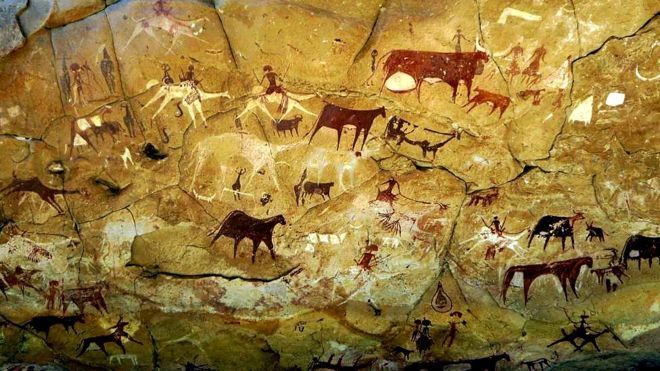
The artworks depict everyday scenes from thousands of years ago
|
Chad's ancient Ennedi cave paintings defaced
20 March 2017
Ancient cave paintings at a world heritage site in the Sahara desert have been defaced with graffiti, Chad's minister of culture has told the BBC.
The graffiti drawn on the paintings, which are about 8,000 years old, was "a tragedy... offensive to the whole history and memory of Chad," Mahamat Saleh Haroun said.
Vandals scrawled their names on top of the artworks in French and Arabic.
The Ennedi plateau was declared a Unesco world heritage site in 2016.
"It's an African story and they wanted to destroy that.
"That's why I'm talking about a tragedy, because it's a part of us," said Mr Haroun, who is also an award-winning filmmaker.
A team has now been sent to the site in north-eastern Chad to assess the damage, with a view to sending experts to follow up.
The head of the UN's cultural body in the country, Abdelkerim Adoum Bahar, told the BBC that he thought the damage could be repaired.
Thousands of images of people and animals have been painted and carved into the rock surface of caves, canyons and shelters in the area, according to UN cultural agency Unesco.
Mr Haroun stressed the historical importance of the site, which he said belonged not just to Chad but to the whole world.
"This is a part of our memory. It helps us to understand who we are... We cannot destroy it. If you don't know your past you cannot deal with the present," he said.
Source: http://www.bbc.com/news/world-africa-39332438
|

The Libyan Sahara. Luca Galuzzi - www.galuzzi.it, Wikimedia Commons
|
Did humans create the Sahara desert?
14 March 2017
New research investigating the transition of the Sahara from a lush, green landscape 10,000 years ago to the arid conditions found today, suggests that humans may have played an active role in its desertification.
The desertification of the Sahara has long been a target for scientists trying to understand climate and ecological tipping points. A new paper published in Frontiers in Earth Science by archeologist Dr. David Wright, from Seoul National University, challenges the conclusions of most studies done to date that point to changes in the Earth's orbit or natural changes in vegetation as the major driving forces.
"In East Asia there are long established theories of how Neolithic populations changed the landscape so profoundly that monsoons stopped penetrating so far inland", explains Wright, also noting in his paper that evidence of human-driven ecological and climatic change has been documented in Europe, North America and New Zealand. Wright believed that similar scenarios could also apply to the Sahara.
To test his hypothesis, Wright reviewed archaeological evidence documenting the first appearances of pastoralism across the Saharan region, and compared this with records showing the spread of scrub vegetation, an indicator of an ecological shift towards desert-like conditions. The findings confirmed his thoughts; beginning approximately 8,000 years ago in the regions surrounding the Nile River, pastoral communities began to appear and spread westward, in each case at the same time as an increase in scrub vegetation.
Growing agricultural addiction had a severe effect on the region's ecology. As more vegetation was removed by the introduction of livestock, it increased the albedo (the amount of sunlight that reflects off the earth's surface) of the land, which in turn influenced atmospheric conditions sufficiently to reduce monsoon rainfall. The weakening monsoons caused further desertification and vegetation loss, promoting a feedback loop which eventually spread over the entirety of the modern Sahara.
There is much work still to do to fill in the gaps, but Wright believes that a wealth of information lies hidden beneath the surface: "There were lakes everywhere in the Sahara at this time, and they will have the records of the changing vegetation. We need to drill down into these former lake beds to get the vegetation records, look at the archaeology, and see what people were doing there. It is very difficult to model the effect of vegetation on climate systems. It is our job as archaeologists and ecologists to go out and get the data, to help to make more sophisticated models".
Despite taking place several thousands of years ago, the implications of humans being responsible for environmental and climatic degradation are easy to see. With approximately 15% of the world's population living in desert regions, Wright stresses the importance of his findings: "the implications for how we change ecological systems have a direct impact on whether humans will be able to survive indefinitely in arid environments".
Source: http://popular-archaeology.com/issue/winter-2017/article/did-humans-create-the-sahara-desert
|
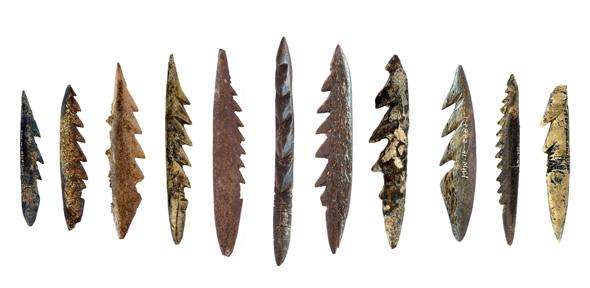
Harpoons discovered by
the In Africa project.
Credit: Alex Wilshaw
|
Sharpening our knowledge of prehistory on East Africa's bone harpoons
20 February 2017
A project exploring the role of East Africa in the evolution of modern humans has amassed the largest and most diverse collection of prehistoric bone harpoons ever assembled from the area. The collection offers clues about the behaviour and technology of prehistoric hunter-gatherers.
East Africa is the epicentre of human evolution and its archaeological remains offer the potential to fill gaps in our understanding of early modern humans from their earliest origins, around 200,000 years ago, through to the most 'recent' prehistory of the last 10,000 years.
The In Africa project, directed by Dr Marta Mirazón Lahr, co-founder of the Leverhulme Centre for Human Evolutionary Studies at the University of Cambridge, is seeking to do exactly that. The group believes that, in East Africa, key ecological and cultural conditions converged, which allowed modern humans to evolve new behaviours and technologies to better exploit the natural resources that they found around them.
For the past five years, they has been working on the palaeoshores of Lake Turkana in Kenya, which has offered significant insights into how people there made use of aquatic resources such as fish or shellfish, something which is seen as a marker of human modernity.
Dr Alex Wilshaw, in Cambridge's Department of Biological Anthropology and a fellow of St John's College, is a Research Associate on the project. "Looking at prehistoric tools and technology is a key way of exploring when and how the cultural and behavioural traits associated with modern humans were developed," he explains.
"The area around Lake Turkana is extraordinarily rich not just in fossils, but also in artefacts used to exploit the ecology of the area. In the case of aquatic resources from the lake, these artefacts are often harpoons or points made from bone. While previous archaeological projects have led to pockets of harpoon discovery, the extent of this project has afforded us the opportunity to collect unprecedented numbers of bone harpoons – to date, we have over 500 from 20 different sites."
Mirazón Lahr and Wilshaw are now preparing a monograph cataloguing and describing the harpoons to give a clearer picture of the diversity that exists within the collection.
"Together, the harpoons have the potential to offer a spatial and temporal cross-section of the activities of early modern humans in the area and tell us something about functional and stylistic changes in technology," Wilshaw says. "The sites contain artefacts from groups who lived at different times and if we look at the harpoons in detail, their distinct styles show signs of variation among different populations and could offer clues about the appearance and disappearance of diverse groups as the lake levels rose and fell over time."
The harpoons range in date from around 13,000 years ago - late in the geological epoch known as the Pleistocene - to around 6,000 years ago, the middle of the current geological epoch known as the Holocene. The researchers used radiocarbon and other dating techniques on samples of shell and sediment surrounding the harpoons to place them in time.
While some of the harpoons were sharpened into elongated spears or barbed points, others look more like hooks. Some have been decorated and polished. "There is some discussion over what the harpoons were used for, but we think it is likely to have been fishing, rather than hunting of land animals, as they were all discovered on the lake edge," Wilshaw explains. "The harpoons would have been attached to a pole or haft and connected using twine or string which then enabled the hunter-fishers to spear their prey and then pull in their catch. There are some huge species of fish native to this area and some of the bigger and thicker harpoons may have been used to catch species like Nile Perch, which can grow up to two metres long. It is possible that the groups were using them to hunt hippo, which were also common in the area."
The research team focused their efforts on recovering remains from across an extensive landscape exhibiting the remnants of the lake edge and its surrounding flood plain. Many animal and human remains were fossilised and preserved in mud and sediment on the shores of the lake, but as the lake shrank and the environment became increasingly dry, the wind and rain eroded the surface and exposed the fossils.
This phenomenon led the group to the discovery not just of the bone harpoons, but also of many other prehistoric human remains and artefacts. Published last year in Nature, such fossilised bones protruding from the earth led to the remarkable discovery of the remains of a group of hunter gatherers who were brutally massacred around 10,000 years ago at the site of Nataruk - the earliest record of inter-group violence among prehistoric nomadic people.
The researchers are hoping to win further funding to unlock more of the secrets of East Africa's prehistoric harpoons.
"Some appear to have been carved from bone, some from ivory and others from horn, but we would like to do a more detailed analysis of what they were made out of and whether there was a preference for material," adds Wilshaw. "Searching for patterns in functionality could reveal whether design and material varied for different prey and how creative the people were being with technology. Interestingly, some of the harpoons also look as if they have been polished and residue analysis could tell us what people were using to care for their tools"
The In Africa project, which was funded by the European Research Council, aims to use its fossils and archaeological discoveries to enhance international awareness of the role of Africa in the evolution of human diversity.
"The harpoons are the iconic remains of a people who have disappeared," says Mirazón Lahr, "when they lived, Lake Turkana was much larger and the environment much richer. These discoveries allow us to track their lives, from when the lake rose as the ice age ended to the point where the lake shrank and desert conditions set in - bringing an end to the tradition that had lasted thousands of years and about which very little was previously known."
Source: https://phys.org/news/2017-02-sharpening-knowledge-prehistory-east-africa.html
|
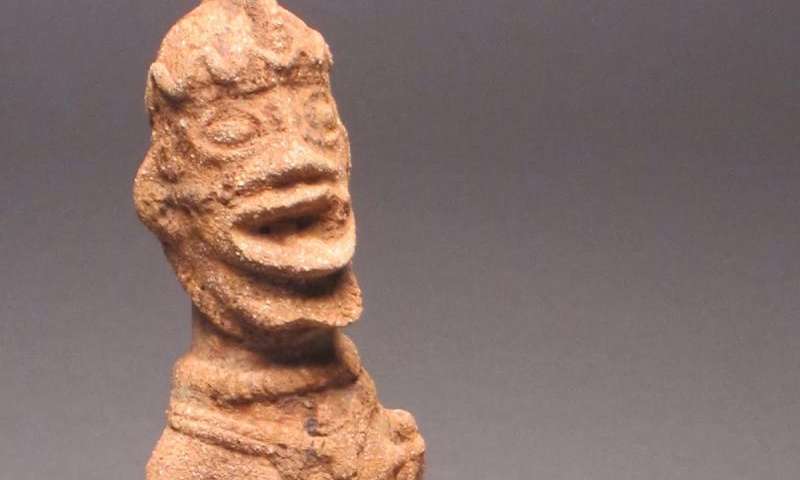
|
Ancient figures reveal trading routes of prehistoric African civilisation
24 January 2017
Researchers from The University of Manchester have completed the very first biological analysis of ancient terracotta figurines found in Ghana, which were created by an unknown civilisation and have become iconic representations of prehistoric African art.
The items were found in Northern Ghana's Koma Land region by Prof. Ben Kankpeyeng and Dr. Samuel Nkumbaan (The University of Ghana). Prof. Timothy Insoll, (formerly at The University of Manchester, now at The University of Exeter), and Dr. Natalie J. Swanepoel of the University of South Africa joined the research in 2010 and 2011 during which some of the figurines were recovered. Many of the figurines are thought to represent ancestral figures or animals, and they reveal the clothing, hairstyles and weapons favoured by the ancient culture.
The hundreds of figurines excavated so far suggest a high level of ritual activity at the site. Some of the figurines contain hollow cavities, which the researchers believe substances were poured into during these rituals.
The figurines were exhibited in 2014 at Manchester Museum's 'Fragmentary Ancestors' exhibition. Despite the fact that high temperatures typically accelerate DNA damage, and there are only a few previous reports of the recovery of ancient DNA from exposed sites in Sub-Saharan Africa as a result, Professor Terry Brown and PhD student Heather Robinson managed to recover ancient DNA from inside three of the figurines using forensic-style swabs and a magnetic extraction method.
The findings of the researchers suggest that exotic plants such as banana and pine, which are not native to Ghana, were prized by the unknown ancient culture for use in religious rituals as well as other West African plants. Banana and pine could only have been obtained via trade with North Africa, and suggest that the prehistoric inhabitants of the Yikpabongo archaeological site were connected to other parts of the World via trade, because banana is an east Asian cultigen.
"This has been an excellent example of the way in which archaeologists and DNA scientists can work together," said Professor Brown. "We were invited to sample the figurines when they were exhibited at the Manchester Museum in 2013, and the interpretation of the DNA results with our collaborators in Ghana has been very exciting."
It is hoped that the findings, published in the Journal of Archaeological Science, will boost local and international efforts to protect the figurines which have been subject to illegal excavation and trade in the past.
Source: https://phys.org/news/2017-01-ancient-figures-reveal-routes-prehistoric.html
|

|
Massive Burial Ground Unearthed at Medieval Monastery in Sudan
19 January 2017
Four cemeteries, from which at least 123 individuals have been excavated so far, have been unearthed near the remains of a medieval Christian monastery in Sudan. A few of the burials contained individuals buried in unusual ways.
The cemeteries and remains, which have been excavated over the past two years, are located at a monastery called al-Ghazali near the Nile River. The people who were buried there lived about 1,000 years ago, during a time when a series of Christian kingdoms flourished in the area, according to Robert Stark, a doctoral student at McMaster University in Hamilton, Ontario, who presented the findings this month in Toronto at the joint annual meeting of the Archaeological Institute of America and the Society for Classical Studies.
The discoveries include well-preserved burial shrouds that in a few instances still cover the skulls of the deceased, Stark said. The archaeologists also found tombstones with engravings of prayers that were written in Greek or Coptic (an Egyptian language that uses the Greek alphabet). In one cemetery, some people were buried in mysterious ways: For example, two individuals were found with post-mortem cut marks incised in their bones. [See Photos of the Massive Burial Ground and Monastery]
Stark is part of an archaeological expedition of the Polish Centre of Mediterranean Archaeology, at the University of Warsaw, which is excavating al-Ghazali.
Massive burial ground
An archaeologist named Peter Shinnie first excavated the cemeteries at al-Ghazali in the 1950s, Stark said. While Shinnie believed al-Ghazali held more than 1,000 burials, he uncovered just a few during the course of his fieldwork. The Polish Centre of Mediterranean Archaeology is the first organization to conduct large-scale excavations at al-Ghazali's cemeteries, he added.
One of the cemeteries consists almost entirely of adult males and was probably used by the monks from the monastery, Stark said. Two cemeteries contain a wider mix of individuals and appear to have been used by people who lived in nearby settlements. The fourth cemetery was discovered recently by archaeologists and contains only 15 burials - and some of those have features that are unusual.
Tombstones
In all four of the cemeteries the remains of stone structures were found on the surface, above the burials, Stark said, adding that some of these structures have the remains of tombstones.
The writing on the tombstones tended to follow a particular format. "To make it simple. The writing on tombstones can be divided into two parts," Artur Obluski, the director of the excavations at al-Ghazali, told Live Science in an email.
The first part consisted of prayers, which included "a prayer for the soul of the deceased, a prayer to the Providence of God, the God himself often described as merciful," Obluski said. These prayers ask "that the soul will be taken care of and can rest on the bosom of Abraham, Isaac and Jacob or in the world of the Living."
The second part of the tombstone engravings "contains some individual information of the deceased: his name, age at the time of death, sometimes titles he bore during his life time - so-called cursus honorum - and professions he performed," said Obluski.
Mysterious cemetery
The graves in the more recently uncovered cemetery showed some unusual features, Stark said.
One burial contains a mix of bones with cut marks from two individuals; an analysis of the bones indicates that the cut marks were incised around the time that the two individuals died.
"All the indicators [are] that this happened when the bones were still quite fresh," Stark said during his presentation, noting that there are no signs that the bones were made by scavenging animals. It's possible that the cut marks were created during some form of defleshing, Stark said.
There were other individuals in the cemetery who were found to be buried in unusual ways. For instance, one person's legs were lying at a 45-degree angle, with the person's right arm dangling across his or her head. This person was buried in a "haphazard" way, Stark said, despite the fact that the person's grave was neatly dug into the ground and a stone structure was apparently built above it.
Source: https://www.livescience.com/57553-burial-ground-unearthed-at-medieval-monastery.html
|

Studies of mounds.
Photo by K. Rak
|
The first Polish archaeological research project in Burkina Faso
2 January 2017
Some of the oldest known traces of settlements known to date in the region, as well as new information on the Kurumba community - these the biggest successes of this year's Polish first archaeological research in Burkina Faso in West Africa.
"Burkina Faso remains a blank spot on the archaeological map of Africa - so far only random excavations have been carried out here. The research project we have started may shed new light on the history of this country since the beginning of human presence in this place" - said in an interview with PAP Krzysztof Rak from the Institute of Archaeology of the Jagiellonian University in Kraków, one of the initiators of the research project carried out in the northern part of the country.
Polish scientists have been studying communities of Burkina Faso for years - director of the Municipal Museum in Zory, Dr. Lucjan Buchalik invited archaeologists to join his research. In addition to Krzysztof Rak, Boguslaw Franczyk of the Institute of Archaeology, University of Warsaw also participated in the project.
During the first season (October and November), archaeologists chose locations to carry out excavations. They focused on Pobé-Mengao department in northern Burkina Faso. "This area is inhabited by the Kurumba - the people that arrived there a few hundred years ago, perhaps from today's Mali or Niger. It is not clear whether it was in the thirteenth or perhaps in the sixteenth century - it is still a matter of dispute among ethnologists. We hope that archaeological research will help to solve this puzzle" - said Rak.
He explained that the Kurumba community counts approx. 300 thousand people. Scientists draw attention to a very extensive mythology of the Kurumba. According to the mythology, their ancestors arrived in the northern part of Burkina Faso in an "iron house". On arrival they subjugated the local population called Berba and created their own kingdom. In the eighteenth century - that we know from ethnological sources - the Kurumba were dominated by the Mossi, but have maintained the old chiefly system headed by the king. While researchers know the list of all the rulers of the Kurumba kingdom - Lurum, it is not clear for how many years each of them had ruled.
Already the first season of work has brought interesting results. Archaeologists conducted surface surveys involving the search for objects such as fragments of pottery on the surface. They found objects including flint tools and waste resulting from processing flint. According to archaeologists, they come from approx. 50-15 thousand years ago. "This is one of the oldest known traces of human presence in this country" - believes Rak.
Archaeologists also focused on the long abandoned settlement Damfelenga Dangomde in the form of a tell (artificial mound formed as a result of settlement from the accumulated remains of, for example, crumbling walls of mud brick houses). So far it was only known that the site was inhabited until the end of the nineteenth century, and then the Kurumba moved to the contemporary capital - Pobé-Mengao.
During surface survey, the scientists discovered artefacts indicating that the tell had been inhabited since the turn of the eras, long before the arrival of the Kurumba - said Rak.
Polish archaeologists were also surprised to discover a necropolis of burial mounds in the vicinity of the tell. Until now, the place was known in the local communications as an abandoned... village.
"It turned out that it was a wrong identification. The mounds of stone and earth that we have studied are approx. 1300 years old" - reported the archaeologist from Kraków. Several dozen such structures are buildings visible in the field to this day. The largest of them is nearly 2 meters high.
Scientists are hoping that they will be allowed to carry out excavations within the royal necropolis, which is located next to the legendary "iron house". "This area is inaccessible to tourists and subject to local taboo. Therefore, conducting research there would be a huge challenge" - said Rak.
This year's research was carried out in collaboration with the director of the Musée du Korum-Wonda, Adama Sawadogo.
PAP - Science and Scholarship in Poland, Szymon Zdzieblowski
Source: http://scienceinpoland.pap.pl/en/news/news,412553,the-first-polish-archaeological-research-project-in-burkina-faso.html
|





























